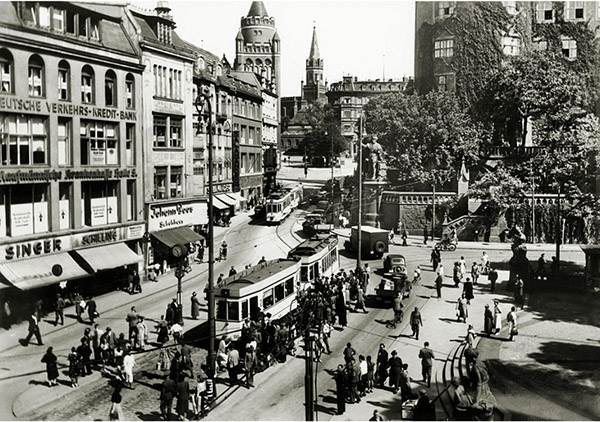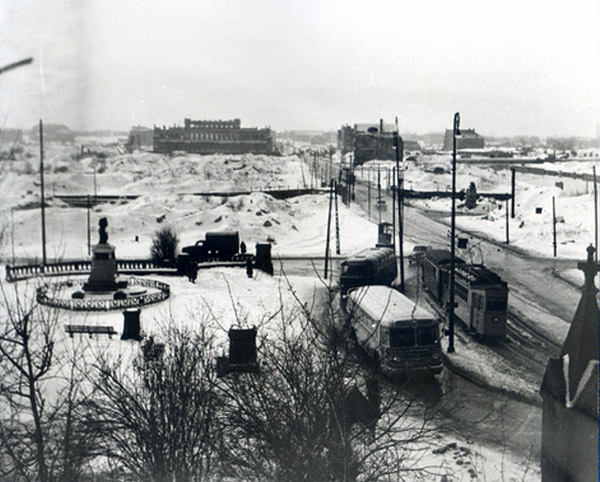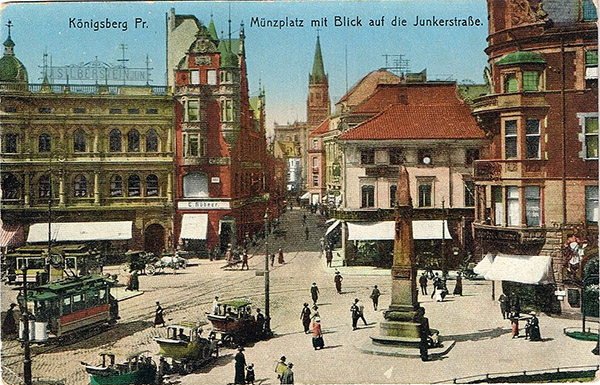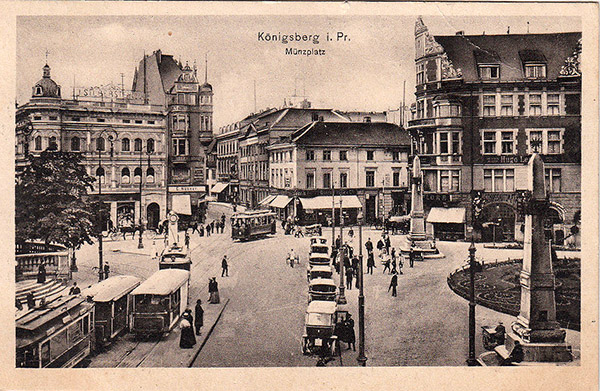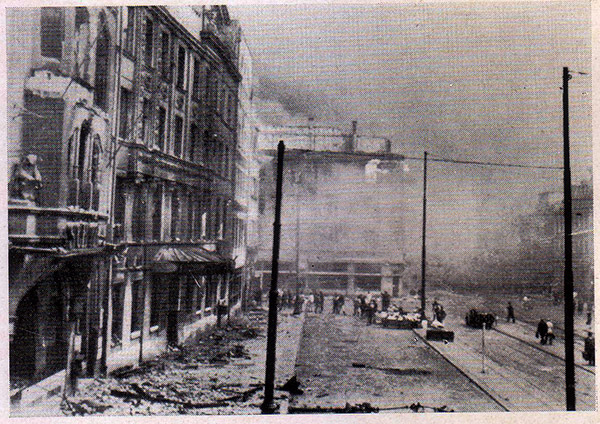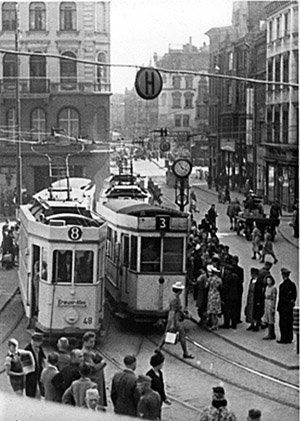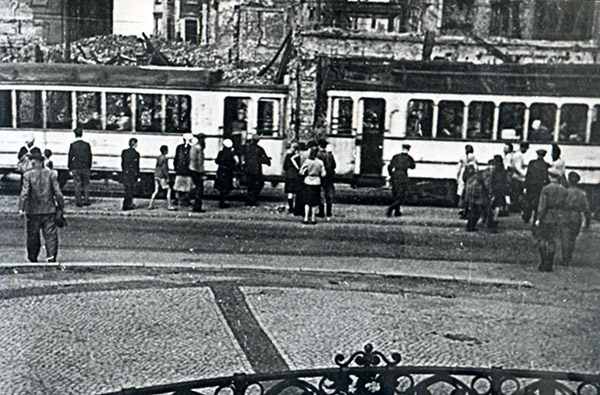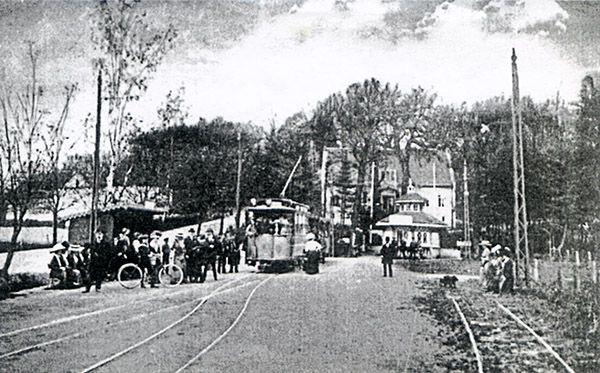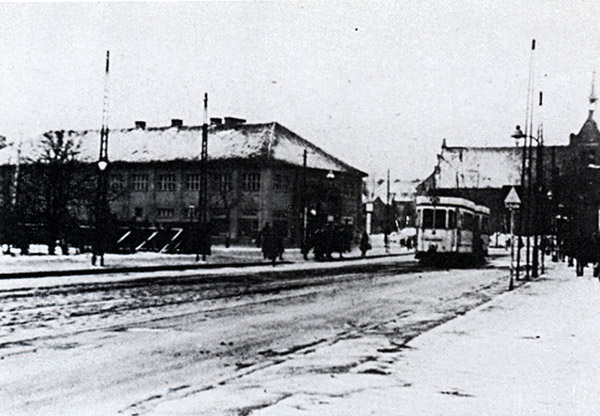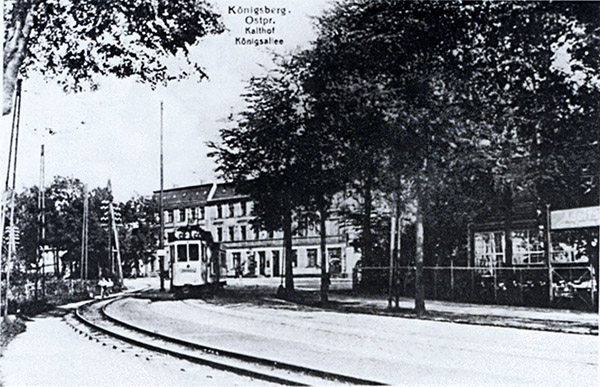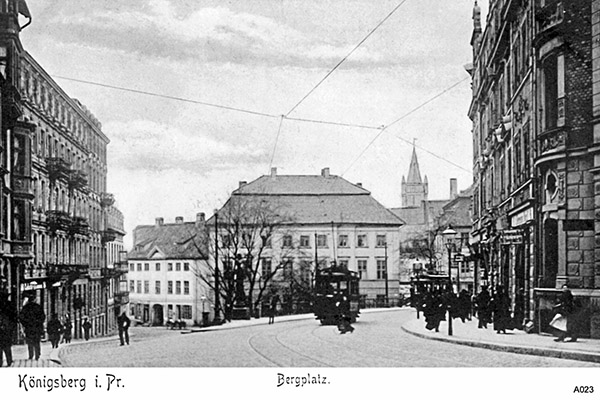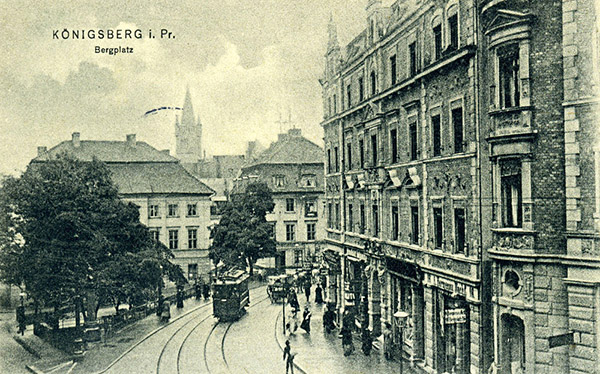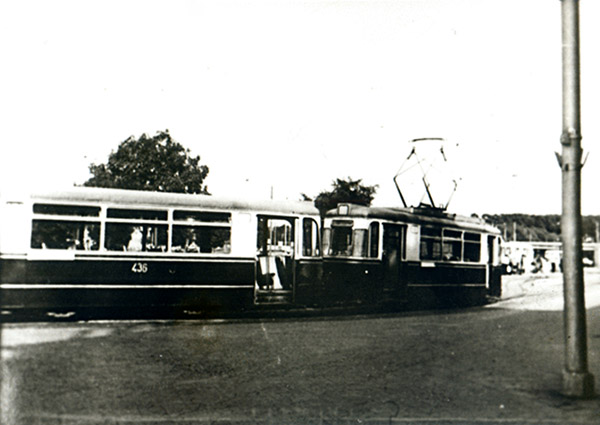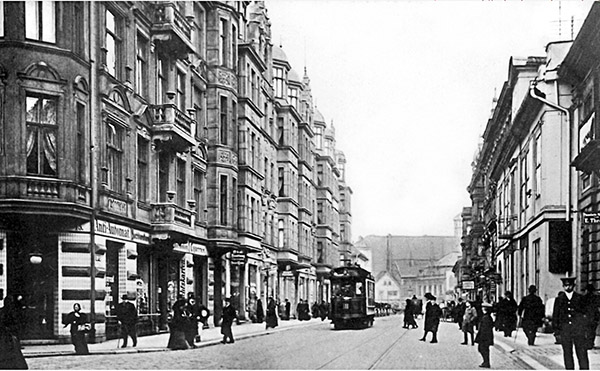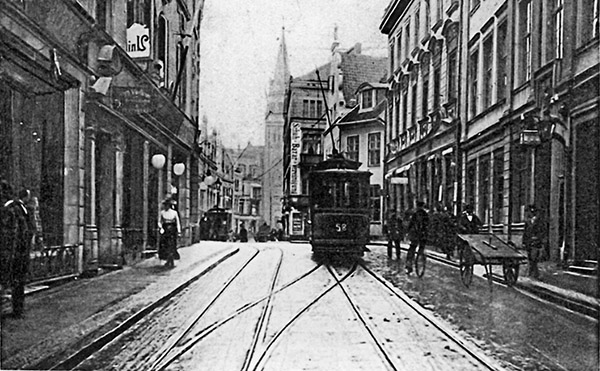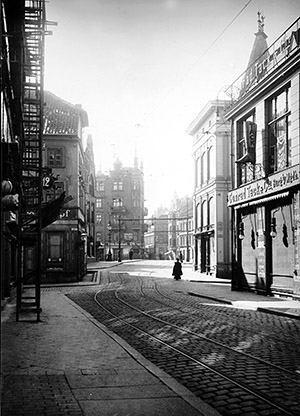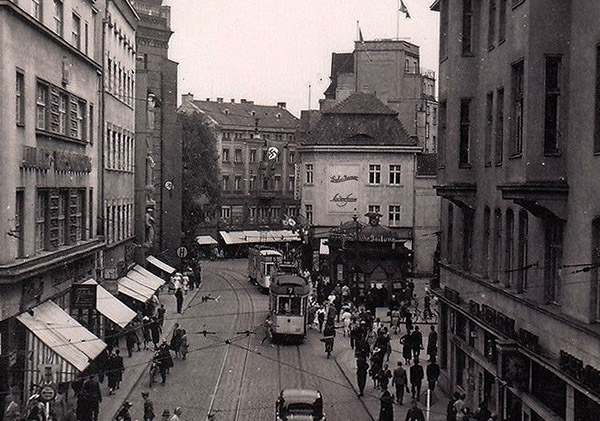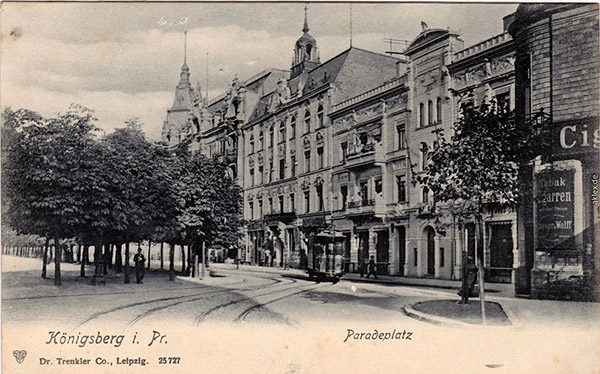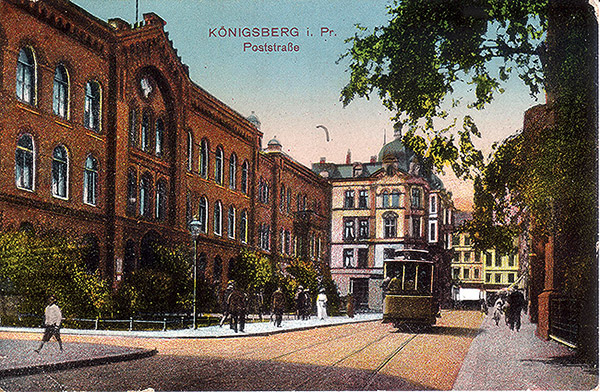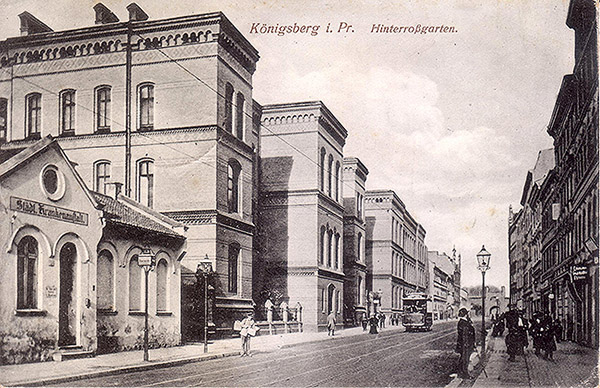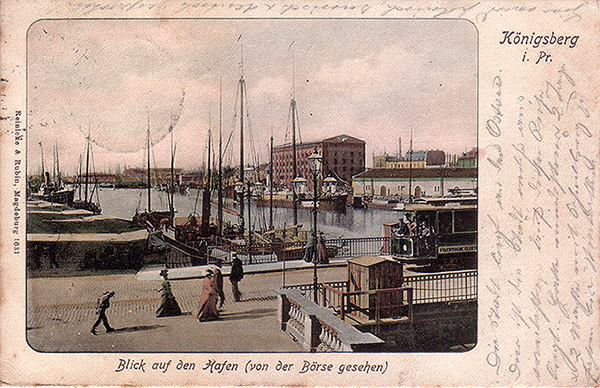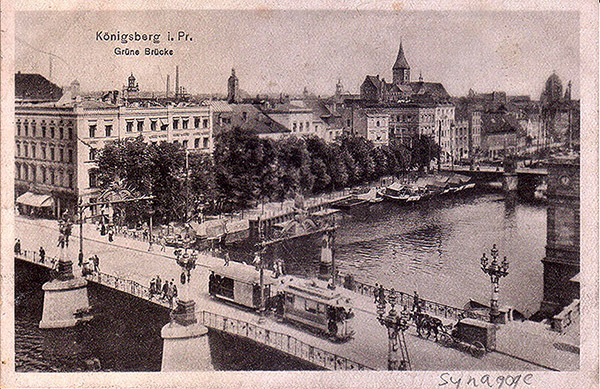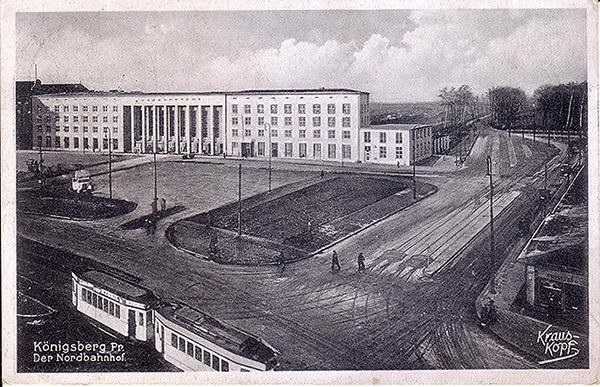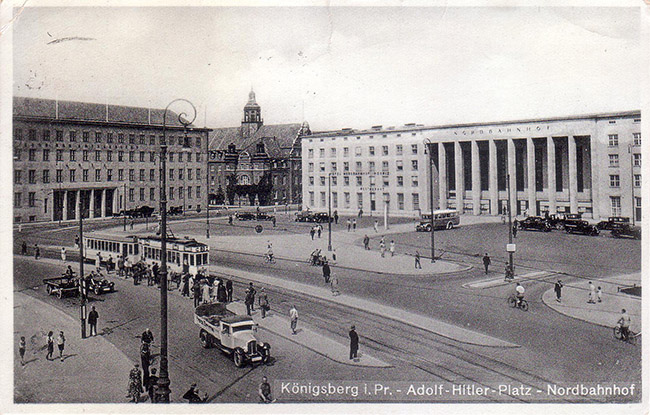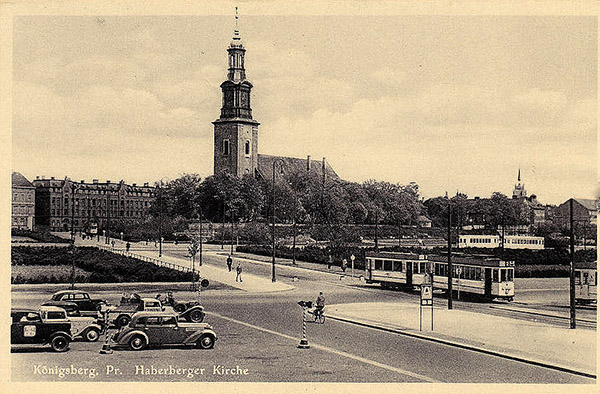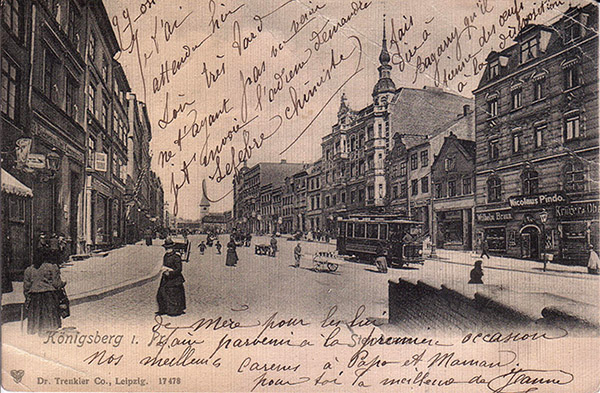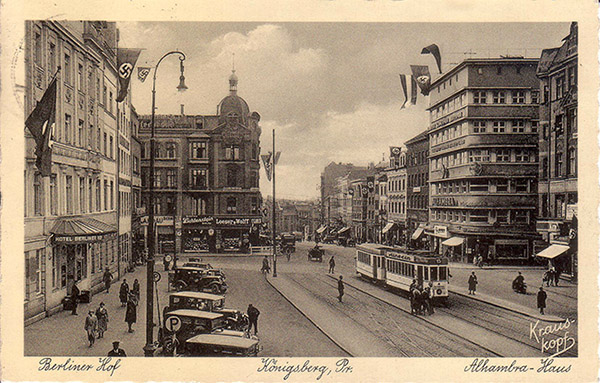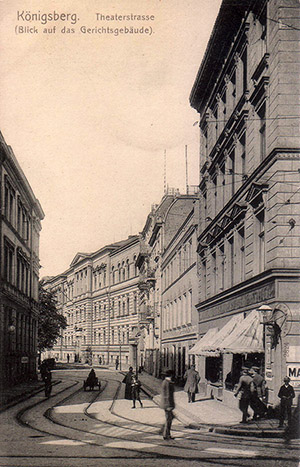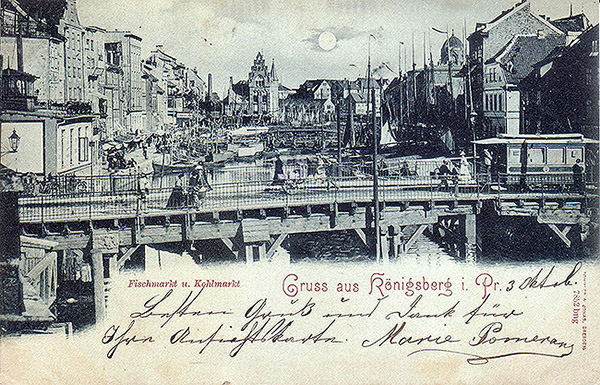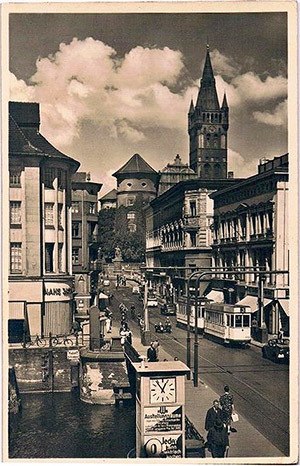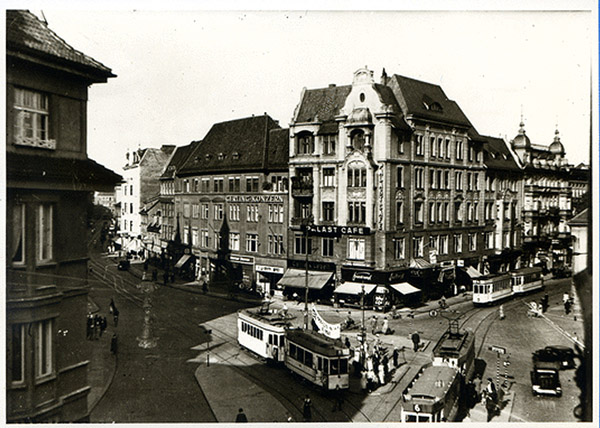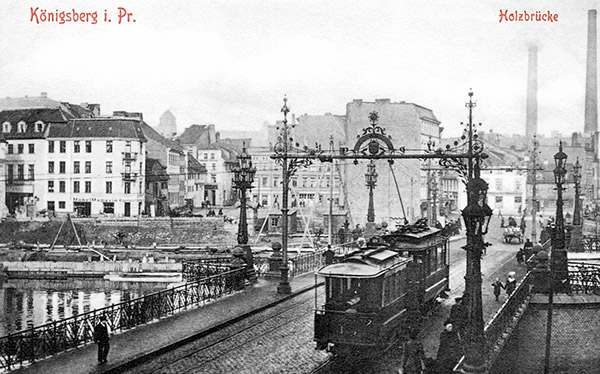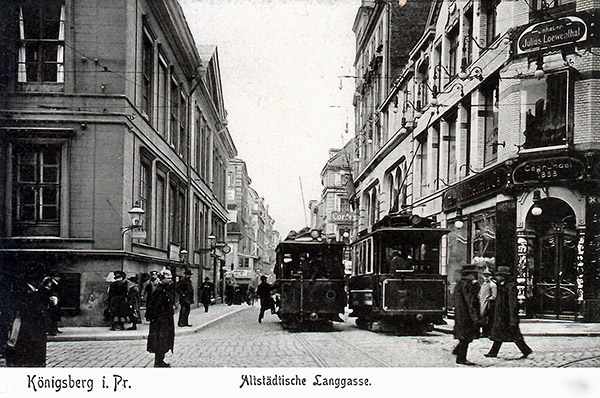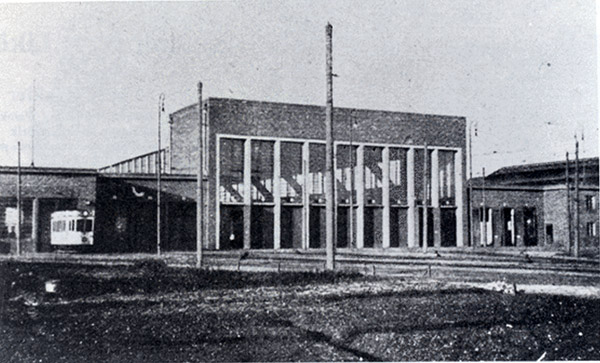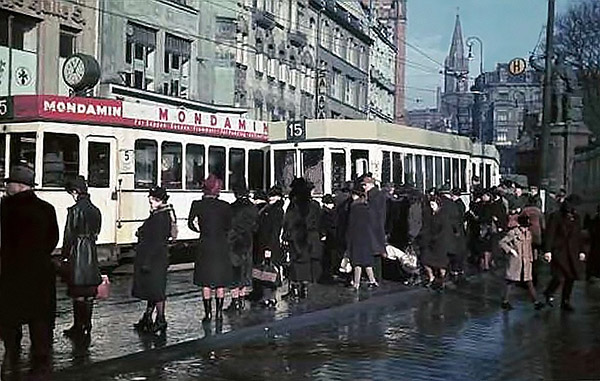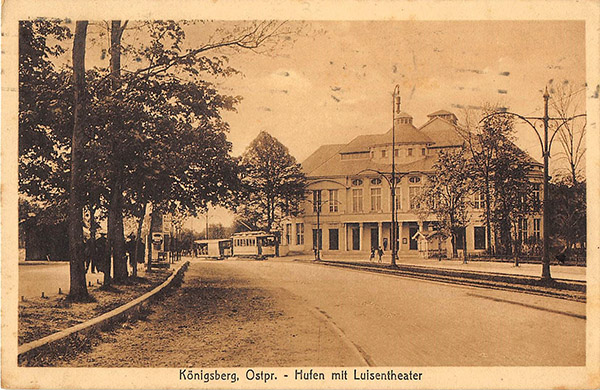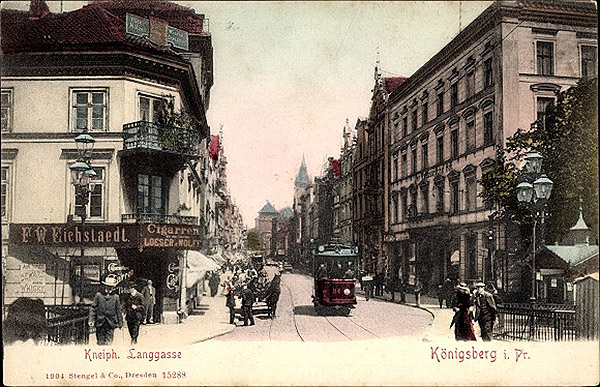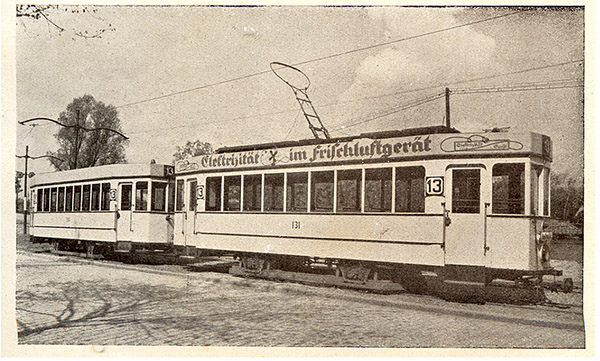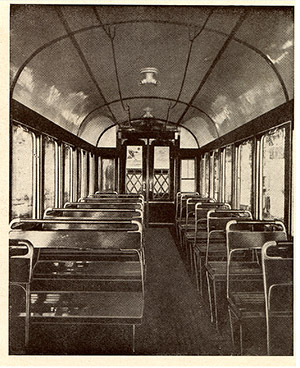Königsberger Tram
Königsberg, the capital of the province of East Prussia, famous for its Albertina University, had the most extensive tram network in the entire province. Königsberg is a city that grew from three small towns - Altstadt, Löbenicht and Kneiphof - into a large (350,000 residents) economic center of East Prussia. Maritime trade occupied an important place in the economy of Königsberg. The port of Königsberg, as an important transshipment base (especially for grain), was connected by a sea canal with Pillau (now Baltiysk. - admin ), located directly on the Baltic Sea. Among the large industrial enterprises of Königsberg, one can mention the branch of the Schichau shipyard from Elbing (now the Yantar shipyard. — admin ) and the Steinfurth wagon factory (now the Kaliningrad Wagon Factory. — admin ). The constantly growing city needed public transport that would connect all areas of the city with its routes, and especially with the main railway station.
Horse-drawn carriage
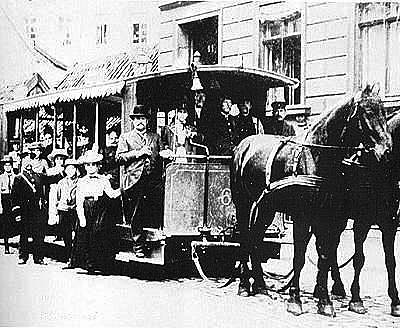
The first to come up with a plan to organize a horse-drawn urban railway (konka) in Königsberg was a certain company from Charlottenburg (it is not entirely clear from the text which Charlottenburg the author has in mind - the Berlin district or the suburb of Königsberg, now the settlement of Lermontovsky. - admin ). The first horse-drawn tram lines began operating in 1881. The "king of the railways" Strousberg had a hand in the emergence of the Königsberg horse-drawn tram (Bethel Henry Strousberg - a native of East Prussia Bethel-Henry Strousberg (or Strousberg, 1823-1884) - a baptized Jew, a railway entrepreneur who built the Tilsit-Insterburg and Southern railways in East Prussia, and was later caught in a scam with a multi-million loan from the Moscow Commercial Bank. - admin ). The Königsberger Pferde-Eisenbahn-Gesellschaft (Königsberg Horse Railway Society) received financial support to purchase the necessary equipment and build the lines. This was a "normal" 1435 mm double track for the unimpeded passing of two carriages. The first four lines were put into operation, as mentioned above, within six months in 1881:
1. Poststraße (now the area of the Kaliningrad Hotel) - Hufen (now the Central Park of Culture and Leisure) - 26.5.1881
2. Kronenstraße (now approximately under the "House of Arts") - Krämerbrücke (now approximately under the overpass bridge over Moskovsky Prospekt) - 5.6.1881
3. Steindammer Tor (not preserved, now approximately the corner of Leninsky Prospekt and Chernyakhovsky Street) — Königstor (King's Gate) — 29.6.1881
4. Bahnhöfe (former Süd- and Ostbahnhof, Polotskogo Street area) — Krämerbrücke — 11.10.1881.
At the beginning of 1882, the second line from Krämerbrücke via Gesekusplatz (now the section of Leninsky Prospekt between the Plaza shopping centre and the former Old Tower shopping centre) and Münzplatz (now Shevchenko Street between the Lower Pond and the House of Soviets) was extended to the Royal Gate, partially using the tracks of the first line.
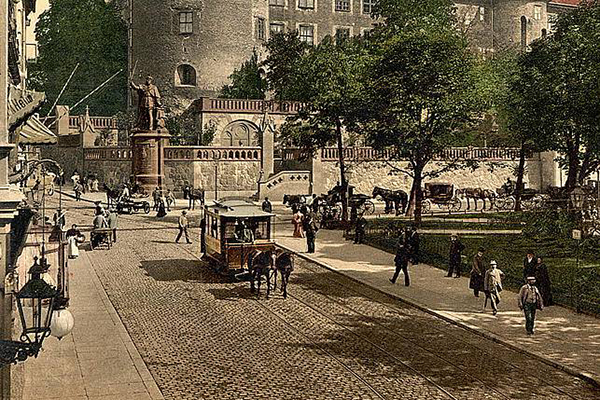
At the end of 1881, the horse-drawn tram had 125 employees. There were 132 horses and five service cars. The total length of all lines was 14,010 m. The depot was located on Heumarkt (now Barnaulskaya Street, closer to Leninsky Prospekt. — admin ). The interval on all lines was 10 minutes, so a horse-drawn tram passed along Steindamm every 3.33 minutes. Each car was pulled by two horses. Additional horses were used on the steep climb to the Royal Castle along Kantstrasse and Schlossstrasse. There were no stopping points. Those wishing to use the horse-drawn tram drew the driver's attention to their direction, and he stopped the car. In good weather in the summer, passengers willingly used the open areas along the car. To get passengers on and off, the driver had to move slightly to the side to clear the passage to the steps. The fare was 10 pfennigs, which was a lot of money at the time, especially considering that the distances were not very long. Nevertheless, the horse-drawn tram was profitable from the very beginning. The conductor's salary was 600 marks per year for a 14-hour working day. At the same time, he was entitled to only half a day off every three weeks. It was easier for the horses - they were changed every four hours. Each horse was entitled to 1.71 marks per day for fodder. Thus, the cost of maintaining a horse per year (624 marks) exceeded the conductor's salary, although he also had a family to support!
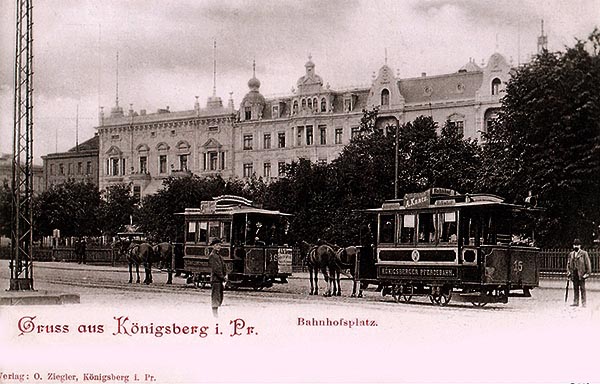
After 1886, the horse-drawn railway network in Königsberg was expanded with three more lines:
5. Roßgärter Markt (intersection of Klinicheskaya and Frunze streets) — Grolmannstraße (now Vasilevsky Square) — 15. 11. 1886
6. Junkerstraße (Shevchenko Street) — Schützenhaus (approximately the corner of Chernyakhovsky and Proletarskaya Streets) — 10. 6. 1887
7. Königstor (King's Gate) - Kalthof (now the area of Gagarin Street south of the intersection with Kuibyshev Street) - 17. 8. 1887.
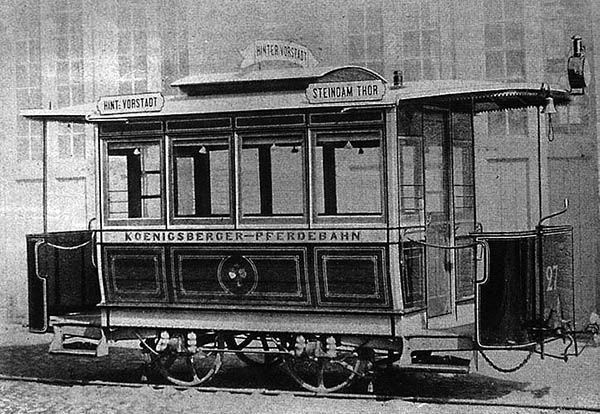
Since 1883, omnibuses – horse-drawn buses – were also launched in Königsberg, which can be considered the predecessors of city buses. Several omnibus lines operated:
Windgasse (intersection of Moskovsky and Leninsky avenues) — Sackheim (intersection of Moskovsky avenue and Litovsky Val)
Roßgärter Markt (intersection of Klinicheskaya and Frunze streets) — Roßgärter Tor (Rossgarten Gate)
Gesekusplatz (now the area near the Plaza shopping center) — Schützenhaus (approximately the corner of Chernyakhovsky and Proletarskaya streets)
Viehmarkt (intersection of Dzerzhinsky and Oktyabrskaya streets) — Brandenburger Tor (Brandenburg Gate).
Due to the poor condition of the pavements, the omnibuses quickly broke down, so in 1892 they had to be abandoned. In 1893, the horse-drawn tram carried 3,220,000 passengers. It reached its peak in 1895, when the total length of the routes was 11 km (the author indicated above that back in 1881 the length of the routes was over 14 km. — admin ). The last horse-drawn tram route (Hinterer Vorstadt — Rhesastraße, from the intersection of Leninsky Prospekt and B. Khmelnitsky Street to the area between Proletarskaya and Sergeyeva Streets) was closed in 1901.
The emergence of the electric tram
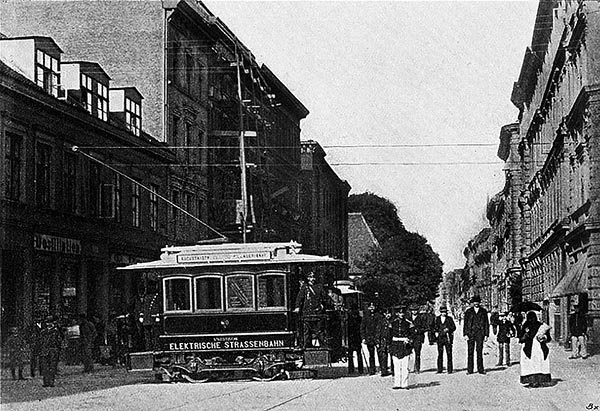
In the 1890s, steps were taken to create an electric tram in Königsberg. This was primarily facilitated by the city council, which included future energy costs for the electric tram in the design capacity of the power plant commissioned in 1890. The city authorities proposed to the Königsberg Horse Railway Society to electrify horse-drawn routes, but they did not find mutual understanding. In connection with this, the city itself assumed the costs of maintaining the tram, for which purpose the enterprise "City Electric Tram" (Städtische Elektrische Straßenbahn (StESt) was created. Fierce competition between horse-drawn trams and electric trams began, since the concession for horse-drawn railways was issued for 40 years, and this condition was fulfilled. This meant that StESt did not have the opportunity to use the existing horse-drawn tram lines, despite the fact that the latter operated on the most popular streets. Therefore, when laying lines for the electric tram, it was impossible to avoid intersections with horse-drawn tram lines. In 1894, the AEG company received the contract for the construction of lines for the electric tram. The first line of two tracks, 2.94 km long, was to run along the following route:
Pillauer Bahnhof — Unterlaak — Altstädtischer Kirchplatz — Munichplatz — Sackheimer Straße — Augusta/Ecke Friedrichstraße (the “7th Continent” store on Mariupolskaya — Moskovsky Prospekt south of Kopernika Street — the intersection of Moskovsky Prospekt and Oktyabrskaya Street — the intersection of Moskovsky Prospekt and Griga Street — the corner of Tomskaya and Griga Streets).
By the time the line opened on May 31, 1895, 8 small two-axle trams had been purchased. Since the route ran along very narrow streets, a meter gauge was chosen. In particularly tight places, two tracks converged into one. A voltage of 500 volts and roller current collectors were used for electric traction. The route immediately became profitable and a decision was made to expand the route network of the Königsberg electric tram. But problems arose even during the construction of the first line. The rector of the Albertina objected to the construction of contact networks, since, based on the experience of the cities of Halle and Breslau, there were concerns that the wires and rails would create electrical interference with the experiments and observations carried out at the university observatory. To solve the problem, it was proposed not to use tram rails for the return current, but instead to use two parallel contact wires instead of “plus” and “minus” (as is used in trolleybus contact lines). The tram therefore had to be equipped with two current collectors. When the problem was solved, they began laying the next lines. They looked like this:
Oberlaak - Schlachthof 4.28 km, opened 6. 3. 1898
Hohe Brücke - Brandenburger Tor 1.84 km, opened 1. 5. 1898
Sackheimer Straße - Sackheimer Tor 450 m, opened 15. 9. 1899
Brandenburger Tor - Schönbusch 2.25 km, opened 8. 8. 1900
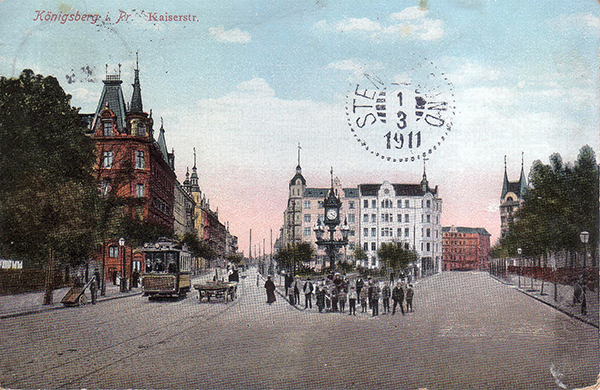
Meanwhile, the shareholders of the Königsberg Horse Railway Company realized that the future of their enterprise depended on the electrification of the routes. As early as 1895, they tried to obtain permission from the city authorities for this. But the city council set the condition for electrification as the transfer of all horse-drawn lines to a meter gauge, which the company did not agree to. The city council deliberately delayed the decision on the issue, since in 1901, after the expiration of the 20-year concession issued to the Horse Railway Company, the city authorities could buy this concession back at a fair price. The company, in turn, tried to avoid this by inflating the value of its assets. In 1898, the company awarded a contract to Siemens-Schuckert for the electrification of two of its routes: Poststraße - Steindammer Tor - Hufen and Ostbahnhof - Kalthof. In exchange for the permission granted to the company, the city authorities obliged it to change the track gauge on these lines to a meter gauge. On May 11, 1900, the first line was put into operation. According to the approved regulations, it was equipped with two-pole contact wires. Beginning on April 1, 1900, the Horse Railway Society was renamed the Königsberg Tramway — Königsberger Straßenbahn AG (KÖSAG). KÖSAG's activities were limited to the area north and northwest of Poststrasse. Thanks to systematic work, by June 18, 1901, the electric tram would replace all horse trams in all directions within the city.
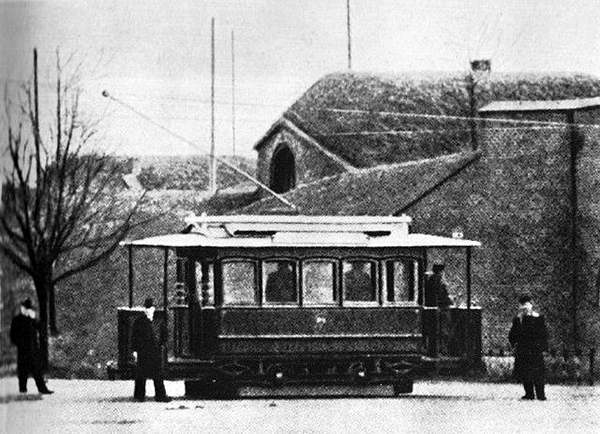
By the beginning of 1903, StESt already had 56.4 km of tram tracks, while KÖSAG had only 12.9 km. Finally, on April 1, 1909, the Königsberg Tram was absorbed by StESt, which belonged to Königsberg. The new company was named Elektrizitätswerke und Straßenbahn Königsberg AG (Königsberg Power Plant and Tram), and in 1920 it was renamed Königsberger Werke und Straßenbahn GmbH (KWS — Königsberg Power Plant and Tram). On June 30, 1909, there were 10 tram routes in operation (the author may have made a mistake, since there are 9 routes, not 10. — admin) :
1. Sackheimer Tor - Cosse
2. Pillauer Bahnhof - Schlachthof
3. Schönbusch - Kaiser-Wilhelm-Platz
4. Pillauer Bahnhof - Augustastraße
5. Ostbahnhof (via Kaiserstraße, Lindenstraße, Münchenhofplatz, Lutherstraße, Mittelanger, Vorder- and Hinterroßgarten, Wrangelstraße, Nachtigallensteig, Paradeplatz, Poststraße, Steindamm, Gesekusplatz, Kantstraße, Kneiphöfsche Langgasse, Vordere Vorstadt, Kaiserstraße) — Ostbahnhof
6. Steindammer Tor - Luisenhöh
7. Kalthof - Ostbahnhof
8. Münzplatz – Maraunenhof
9. Luisenallee - Main Bahnhof.
The color designations of the routes were replaced by numbers in 1910. Also, back in 1909, the need to use cars with two-pole roller current collectors, which had worked for almost 10 years, disappeared. And in 1912-1913, they were replaced by cars with arched (toggle) current collectors.
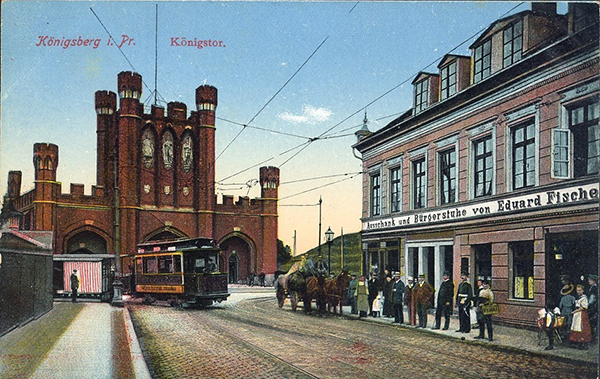
Since the tram depot on Aweider Allee (now Smelikh Alley. — admin ) could no longer cope with the increased number of rolling stock, two new depots were built. In 1905, a tram depot was opened in Cosse (now the area south of the railway tracks between Remeslennaya and Magnitnaya streets). The second depot was located in Hufen, on Hindenburgstraße (approximately at the intersection of Leonov and K. Marx streets. — admin ). Overall, the updated Königsberg tram was profitable.
(From the book "Welfare during Königsberg i. Pr. und Umgebung", written by W. Sahm, Königsberg i. Pr., 1910)
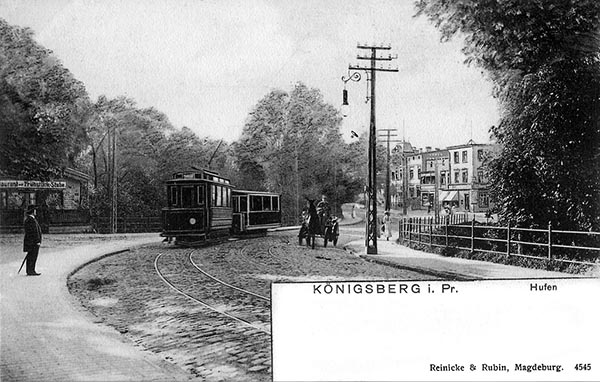
City electric tram ( Stadtische
elektrische Strassenbahn )
- Sackheimer Tor - Cosse . The sign and lights are green.
Route: Sackheimer Tor - Sackheim - Munichplatz - Altstädtische Langgasse - Kaiser-Wilhelm-Platz - Laak - Lizent-Bahnhof - Holländerbaumtor - Holsteiner Damm - Cosse.
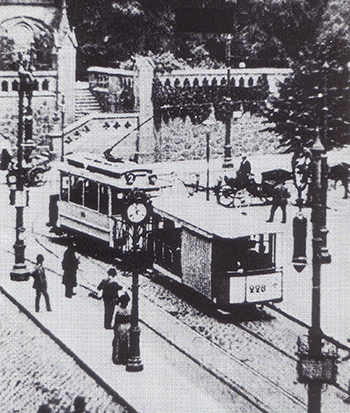
Interval of movement: 15 min.
- Augustastraße — Lizent-Bahnhof . The sign and lights are white and green.
Route: Augustastraße – Sackheim – Munichplatz – Altstädtische Langgasse – Kaiser-Wilhelm-Platz – Laak – Lizent-Bahnhof.
Interval of movement: 15 min.
Between Sackheim - corner of Augustastraße and Lizent-Bahnhof, there were also carriages on the Sackheimer Tor - Cosse line (7.5 min.)
- Schlachthof - Tiergarten . The sign is white with a blue stripe, the lights are white and blue.
Route: Schlachthof (Rosenau) — Friedländer Tor — Viehmarkt — Hohe Brücke — Weidendamm — Honigbrücke — Domplatz — Schmiedebrücke — Schloßplatz — Münzstraße — Mitteltragheim — Schönstraße — Fließstraße — Wrangelstraße — Steindammer Tor — Hufenallee — Tiergarten.
Movement interval: 10 min.
- Viehmarkt — Amalienau . The sign and lights are white.
Route: Viehmarkt - Unterhaberberg - Vorstadt - Kneiphöfsche Langgasse - Kaiser-Wilhelmplatz - Gesekusplatz - Steindamm - Steindammer Tor - Hufenallee - Tiergarten - Lawsker Allee - Amalienau (Korinthenbaum).
Interval of movement: approximately 7 min.
- Kaiser-Wilhelm-Platz — Ponarth . The sign is white with red stripes. The lights are red and white.
Route: Kaiser-Wilhelm-Platz — Kneiphöfsche Langgasse — Vorstadt — Alter Garden — Brandenburger Tor — Nasser Garten — Nassengärter Tor — Schönbusch — Ponarth.
Movement interval: 10 min.
- Königstor — Luisenallee . The sign and lights are yellow and red.
Route: Königstor - Königstraße - Roßgärter Markt - Französische Straße - Schloßplatz - Junkerstraße - Poststraße - Steindamm - Steindammer Tor - Tiergarten - Luisenallee.
Interval of movement: 7 min.
- Münzplatz — Maraunenhof . The sign and lights are blue.
Route: Münzplatz - Münzstraße - Mitteltragheim - Nachtigallensteig - Kurassierwallstraße - Wrangelturm - Oberteichterrasse - Maraunenhof.
Interval of movement: 20 min.
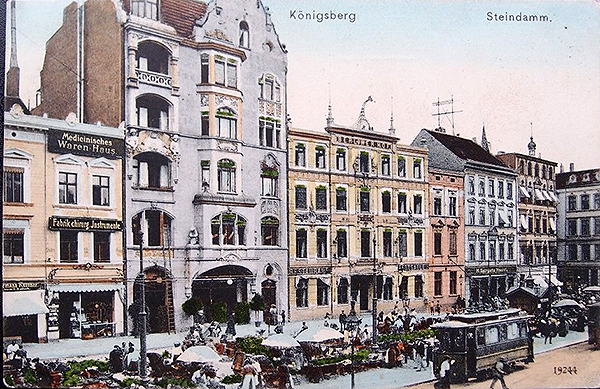
Routes starting from train stations
8. Bahnhofsring . Sign Hauptbahnhof - Vorstadt - Tragheim - Roßgärter Tor. Lights are red and green.
Hauptbahnhof — Weidendamm — Roßgarten — Roßgärter Tor. Green sign with red frame. Red-green lights.
Route: Hauptbahnhof — Bahnhof Straße — Vorstadt — Kneiphöfsche Langgasse — Kaiser-Wilhelm-Platz — Gesekusplatz — Steindamm — Poststraße — Paradeplatz (Theater) — Mitteltragheim — Schönstraße — Nachtigallensteig — Roßgärter Tor — Roßgarten — Roßgärter Markt — Mittelanger — Münchenhofplatz — Holzbrücke — Weidendamm — Kaiserbrücke — Kaiserstraß — Hauptbahnhof.
Interval of movement: 7 min.
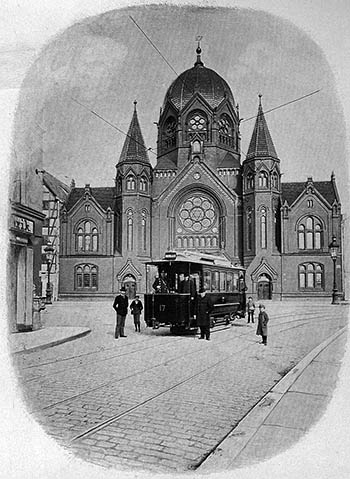
9. Hauptbahnhof — Kalthof . The sign and lights are yellow.
Route: Hauptbahnhof - Vorstadt - Kneiphöfsche Langgasse - Kaiser-Wilhelm-Platz - Kantberg - Schloßstraße - Schloßplatz - Französische Straße - Bergplatz - Roßgärter Markt - Königstraße - Königstor - Kalthof.
Interval of movement: 7 min.
10. Hauptbahnhof — Samland- und Cranzer Bahnhof — Hermannsallee . The sign and lights are yellow and blue.
Route: Hauptbahnhöfe — Kaiserstraße — Vorstadt — Kneiphöfsche Langgasse — Kaiser-Wilhelm-Platz — Gesekusplatz — Steindamm — Steindammer Tor — Cranzer Bahnhof — Samlandbahnhof — Fuchsberger Allee — Mozartstraße — Haydnstraße — Beethovenstraße — Bahnstraße — Hermannsallee — (corner of Luisenallee).
Movement interval: 10 min.
11. Hufenring . Lights of the "Hufenring". Sign: Poststraße — Tiergartenstraße — Bahnhof Mittelhufen — Poststraße — Fuchsberger Allee — Bahnhof Mittelhufen yellow and white.
Route: Poststraße — Steindamm — Steindammer Tor — Hufenallee — Tiergarten — Tiergartenstraße — Tiergarten-Festhalle — Markthalle — Mittelhufen Bahnhof — Bahnstraße — Hardershof — Fuchsberger Allee — Vorderhufen Bahnhof — Samland-Bahnhof — Cranzer Bahnhof — Steindammer Tor — Steindamm — Poststraße.
Movement interval: 10 min.
12. Poststraße - Juditten . The sign and lights are red.
Route: Poststraße - Steindamm - Steindammer Tor - Hufenallee - Tiergarten - Amalienau - Ratshof - Lawsken - Juditten (Luisenthal).
Frequency: 20 min., in summer on Sunday afternoons: 10 min.
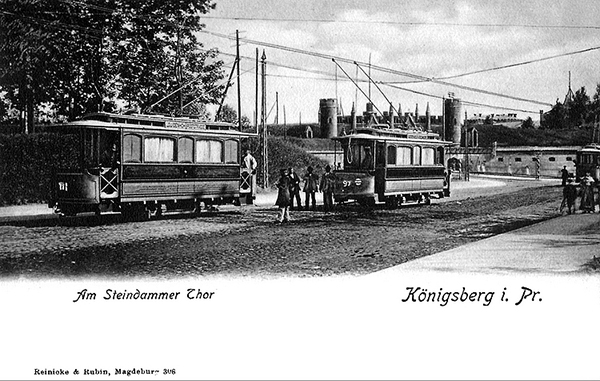
By the beginning of World War I, the length of all routes was 43.9 km, the length of the tracks was 87.4 km. 153 motor cars and 77 trailer cars operated on 14 lines. The number of passengers carried had tripled since the beginning of the century and was 27.6 million. Shoemakers and tailors were hired to work at the tram depot to sew uniforms.
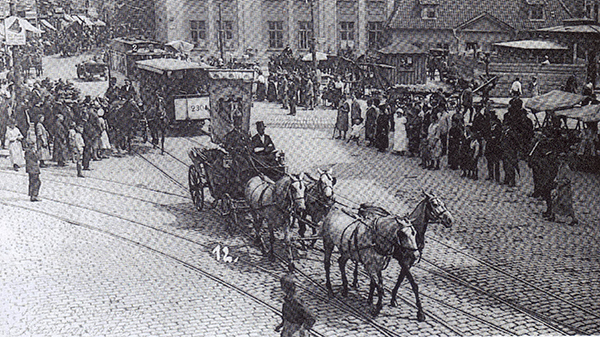
World War I
Already at the very beginning of the first great world fire, Königsberg found itself in a threatening situation. Russian troops invaded East Prussia from the east and south. And although the advance of Russian troops was stopped at the borders of Deima, there was a fear that if the offensive was resumed, the Russian army would capture Königsberg.
The narrow-gauge railway (750 mm gauge) built in 1900 between Königsberg and Possindern (now the village of Roshchino in the Gvardeisky District. — admin ) was used to transport and supply troops, as well as to transport the wounded. Near the final tram stop in Kalthof there was also a narrow-gauge railway stop, and the tram could be used for further travel within the city. The battles on the Deime River were bloody, and several tram cars were specially converted to transport the wounded to Königsberg hospitals. They were placed at the disposal of the East Prussian branch of the Red Cross and a special image was painted on them. During the fighting, these cars were on duty at the final stop, waiting for the wounded to be transported along the narrow-gauge railway. These carriages then remained under the control of the Red Cross for transporting the wounded from train stations to hospitals.
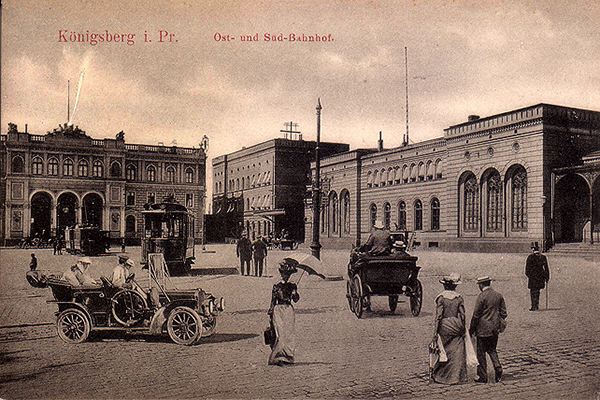
Between the World Wars
Despite the proximity of the front, Königsberg survived the First World War without losses. Of course, due to the lack of funds and materials, the rolling stock and the condition of the tram tracks fell into some decline. The years of inflation that began after the war did not improve the situation either. Therefore, starting in 1924, it was necessary to make up for lost time - the technical re-equipment of the tram fleet and the restoration of the tracks began. If at the beginning of 1924 the length of the tram route network was 41 km (while it was said above that before the beginning of the First World War the length of the route network was 43.9 km. - admin ), then by 1938 it had increased by 20% - to 50 km.
The following lines were built:
1924 — Roßgärter Tor — Krematorium and Kath. Kirchenstrasse — Flughafen
1925/26 - Kronenstraße - Ponarth East
1926 — Ponarth Bahnhof—Ponarth West
1927 - Waldburgstrasse - Fritzener Weg
1927 — Hammer — Art Academy
Thus, by the beginning of the 1930s the tram network was formed, and only two small sections were introduced during these years:
1933 — Fritzener Weg — Grünhofer Weg
1938 — Krematorium — Herzog-Albrecht-Allee.
The problem with the main highway Steindamm — Kaiser-Wilhelm-Platz — Kneiphöfsche Langgasse remained. Several routes from the outskirts of the city ran along it. But in the Kantberg area there was a steep climb with a slope of 1:20, which was difficult for trams to overcome. In addition, trams twice followed the drawbridges over the Pregel, and until 1926 there were no contact wires on the bridges, and trams had to cross the bridges at full speed. In 1927, with the laying of a contact line, the situation improved. But the bridges were raised daily to allow ships to pass along the river, which led to the suspension of tram traffic for this time. In addition to everything, the Kneiphofsche Langgasse street was extremely narrow and cramped, and the decision to widen it would have led to the demolition of several old buildings.
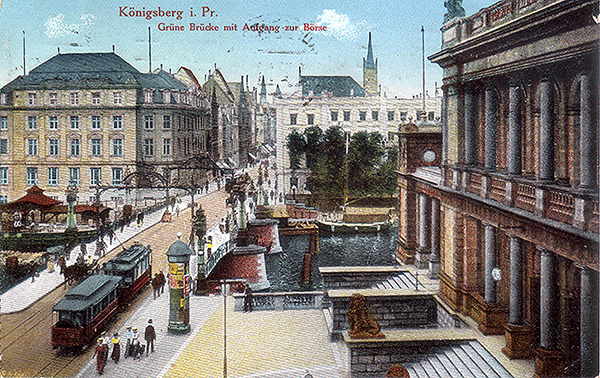
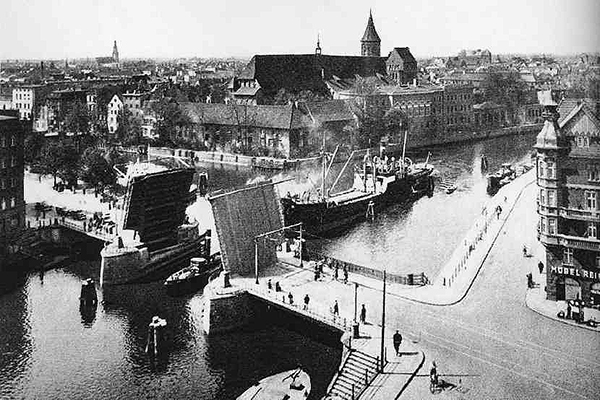
To solve these problems, back in 1926, Professor Giese proposed a plan to build a tunnel under both branches of the Pregol, but due to the high technical complexity and significant financial costs, the project was never implemented.
Car park
As already mentioned, the First World War and the subsequent years of inflation led to the fact that the technical resource of the rolling stock of the Königsberg tram depot was largely exhausted. The renewal of the car fleet began in 1923. By 1931, the Steinfurt plant had delivered 115 motor cars and 80 trailer cars. But the Great Depression interrupted the renewal process. In 1938, the city purchased 3 used motor cars and 3 trailers from Karlsruhe. Thus, even at the beginning of the Second World War, Königsberg continued to use trams manufactured before the First World War. Of course, all these cars were modernized in 1931 and brought closer to new ones in their characteristics. The number of seats in them increased from 19 to 25. Longitudinal benches were replaced with transverse seats. The modernization of the cars, however, led to increased lateral rolling. However, all of them were equipped with electric heaters, which had previously been considered an unaffordable luxury. Manual couplings were replaced with automatic Scharfenberg couplings . This simplified maneuvering and reduced the risk of accidents, and also freed the trailer cars from jerking when braking and starting off. The lyre-shaped drag current collectors, wittily nicknamed "beaters" by the residents of Königsberg, were replaced with pantograph ones, which did not need to be folded back when changing direction, while due to the vertical pressure they had better contact with the wires. Beginning in 1936, the old motor cars were equipped with new engines, with a capacity of 53 or 61 hp, which increased the speed of travel. At the beginning of World War II, 20% of the Königsberg tram consisted of cars modernized in this way. But even all these measures allowed the tram company to barely cope with the increased passenger flow.
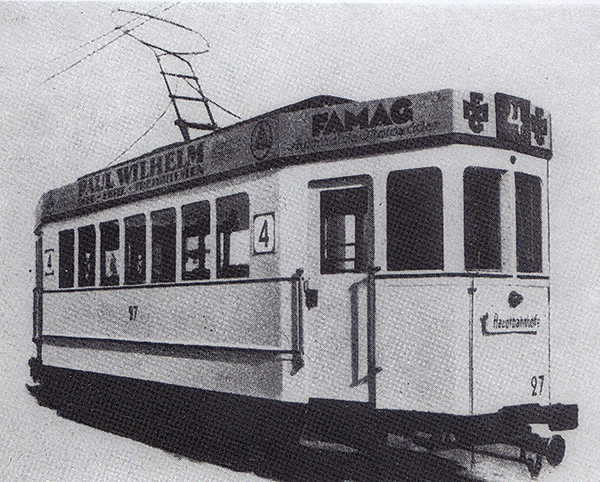
During the First World War and the years of inflation, tram routes 9 and 13 were discontinued, and routes to Juditten, Flammer and Maraunenhof were shortened. Only in 1924 was the route network restored to its pre-war size. In addition, line 15 from Rossgarter Markt was extended to the crematorium (now the Emergency Hospital on Alexander Nevsky Street. — admin ).
By the end of 1924, the route network of the Königsberg tram looked like this:
| Line 1 |
Bahnhofsring (Hauptbahnhof — Kaiserstrasse — Lindenstrasse — Anger-Rossgarten — Tragheim — Paradeplatz — Poststraße - Steindamm - Kantstraße - Kneiph. Langgasse - Vorstädt. Langgasse — Kaiserstrasse - Main Bahnhof) |
7.27 km |
|
Line 2 |
Main Bahnhof — Flughafen | 5.55 km |
|
Line 3 |
Main Bahnhof - Hammer | 5.96 km |
| Line 4 | Viehmarkt - Amalienau | 6.3 km |
| Line 5 | Schlachthof — Munich | 2.8 km |
| Line 6 | Horseshoe — Hammer Road | 5.51 km |
| Line 7 | Poststraße — Juditten | 6.71 km |
| Line 8 | Münzplatz - Maraunenhof | 4.34 km |
| Line 9 | Sackheimer Tor — Bhf. Hollanderbaum | 3.74 km |
| Line 10 | Sackheimer Tor - Cosse | 4.54 km |
| Line 11 | Kaiser Wilhelm Square — Bhf. Ponarth | 5.5 km |
| Line 12 | Poststraße - Hardershof | 3.19 km |
| Line 13 | Poststraße - Luisenallee | 3.12 km |
| Line 15 | Roßgärter Markt — Krematorium | 3.31 km |
| Total | 67.84 km |
(line 14 is missing from the route network given in the book. — admin )
Over the next few years, the route network underwent only minor changes. On 15 October 1926, route 15 was extended to Ponarth Ost. At the same time, route 11 was extended to Ponarth West. Part of route 15 was given over to route 8, which now ran from Maraunenhof to the crematorium via Münzplatz and Rossgarter Markt. This made it possible to get rid of two terminal stations in the city centre. In the autumn of 1927, line 15 was extended to Luisenallee (Komsomolskaya Street. — admin ). Route 13 was extended to Kunstakademie (Academy of Arts, now School No. 21. — admin ), and in the other direction to the Main Station (South Station. — admin ). Line No. 4 was extended to Ratshof (approximately the corner of Pobedy Avenue and Radishchev Street. — admin ). Route No. 14 also reached here from Tragheimer Palve (Gorky Street behind the railway bridge. — admin ). Thus, by 1927, transport links with the northwestern outskirts of Königsberg had significantly improved.
Since 1928, route No. 5 was cancelled. At the same time, line 4 was extended from Viehmarkt to the slaughterhouse (now the Kaliningrad meat-packing plant on Smelykh Alley. — admin ).
The tram tracks themselves also improved significantly. If in 1924 approximately 10 km of tracks were single-track, then by 1938 only 2 km remained. The main obstacle to track expansion was still the narrow streets in the center of Königsberg. But where possible, work was carried out in the city center to improve the condition of the tracks. The main sore spots were Kaiser-Wilhelm-Platz, Münzplatz and Rossgarter Markt. The most problematic area was the section from Kaiser-Wilhelm-Platz to Poststrasse, where in just 500 meters the tram tracks passed through 6 intersections with intense automobile traffic. The solution to the problem lay in organizing traffic in parallel streams.
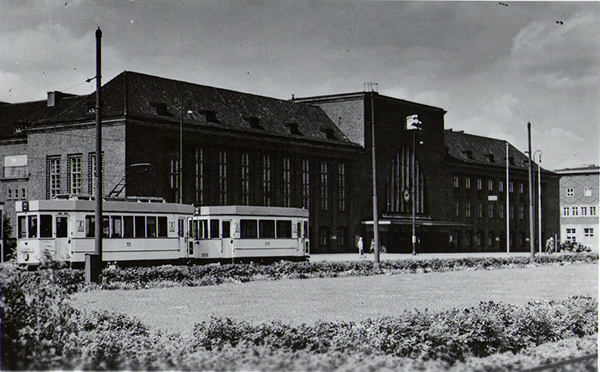
In 1929, the construction of the Main Railway Station (Hauptbahnhof, now the Southern Station. — admin ), the design of which had been prepared before the First World War, was completed. This made it possible to eliminate the tram routes to the old station, located in the city center (in the area of Polotskaya Street. — admin ). These routes had always been problematic due to the constant growth of street car traffic and the narrowness of the streets. It became possible to organize a turning loop for trams near the new station. But at the same time, the tram route to the new station became 440 m longer. In addition, it was laid through a sparsely populated area. Passenger traffic did not increase, but the annual costs of maintaining the tracks increased by 70,000 marks due to an additional 180,000 wagon-kilometers. The construction of a new tram depot on Dirschauer Straße (Kievskaya Street, the tram depot is still located there. — admin ) in 1929-1931 contributed to a reduction in costs. The old tram depot was used as a repair shop. The convenient location of the new depot made it possible to reduce the volume of empty car-kilometers by 210,000 per year. The construction of Nordbahnhof (Northern Station. — admin ) instead of the two previous railway stations — Cranzer- and Samlandbahnhof — and the organization of a turning loop for trams near it also contributed to the improvement of the performance of the Königsberg tram. And even after 1938, when the final stop near the Northern Station was abolished, the turning loop was left for traffic during industrial exhibitions. Later, large turning loops were built on Hammer (Mira Avenue at the intersection with Basseynaya Street), Herzog-Albrecht-Allee (Telmana Street), Königstor (King's Gate), Schlachthof (Smelykh Alley), Hammerweg (Mira Avenue at the intersection with Pobedy Avenue) and Ponarth Ost (near the Rodina cinema).
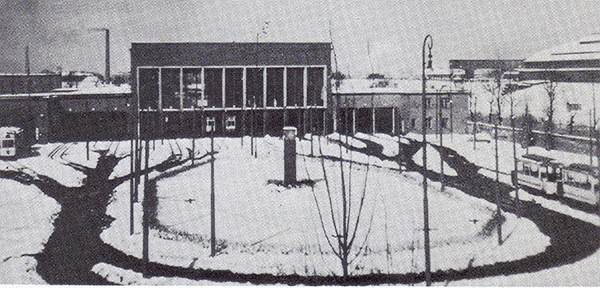
Tragheim also underwent significant changes in 1934-1936. Work was carried out on Wrangelstraße (Chernyakhovskogo Street) and Mitteltragheim (Proletarskaya Street) to widen the streets. The tram tracks (partly single-track) on the narrow and crooked streets of Fleiß (Rokossovskogo Street) and Nachtigallensteig (between Proletarskaya and Sergeyeva Streets) were replaced with new ones. The demolition of the former cuirassier barracks (in the area of the southwestern part of the Upper Pond. — admin ) made it possible to connect Mitteltragheim and Cecilienallee (now Proletarskaya Street before and after the intersection with Chernyakhovskogo Street. — admin ), which reduced the tram travel time along the route by two minutes.
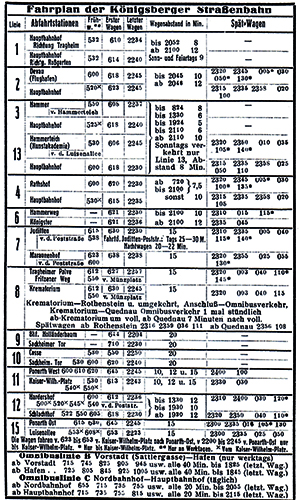
After the opening of the new Main Railway Station on September 19, 1929, routes 1, 2, 3, 13 underwent significant changes. The section of the route along Kaiserstraße (Polotskaya Street) to the old Main Railway Station was cancelled. This was followed by protests from local residents, who now had to walk approximately 300 m to the nearest tram stop. The option of launching a trolleybus between the Main and Northern Railway Stations was not implemented. Line 4, which had previously not served the old Main Station, now went to the new Main Station. There were requests from passengers in various areas of Königsberg to extend some lines to the new Main Station. However, research showed that only 7% of passengers go directly to the station, and these requests were ignored. Route 12 replaced line 4 on the section from Poststrasse to the slaughterhouse. Routes 7 and 8 were completely renewed. The "seven" now ran from Juditten via Poststrasse and Paradeplatz to Maraunenhof. At both endpoints of this route, the passenger flow increased on Sundays, which required a tighter tram schedule. Both renewed lines also ran from the outskirts of the city to both city theaters. Line 8 now connected the crematorium (A. Nevskogo Street near the Emergency Hospital) and Zamiterallee (near Gorky), passing through Rossgarter Markt, Münzplatz and Tragheim. This made it possible to abandon route 14.
(from "Guide to Königsberg and its Environs", 6th edition, Königsberg, 1930)
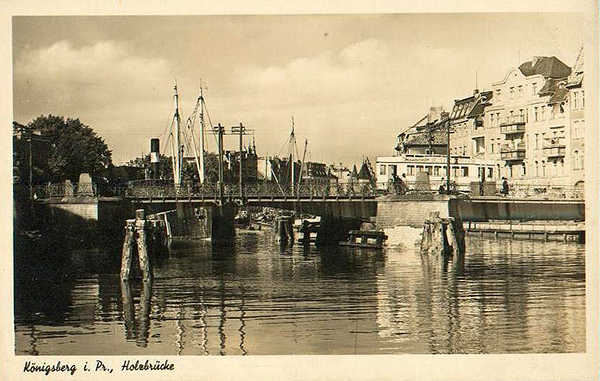
Tram and bus traffic
A regular one-way trip on a tram cost 20 pfennigs, a trip with a transfer also cost 20 pfennigs (meaning that in this case you had to buy a special ticket. — admin ). The night fare was 30 pfennigs.
Line 1. Bahnhofsring: Hauptbahnhof - Vorstädt. Langgasse — Kaiser Wilhelm Square — Poststraße — Paradeplatz — Tragheim — Roßgärter Markt — Munich Marketplace — Weidendam — Kaiserstraße — Main Bahnhof and train station.
Line 2. Hauptbahnhof - Devau - (Flughafen): Hauptbahnhof - Vorstädt. Langgasse — Kaiser-Wilhelm-Platz — Schlossplatz — Roßgärter Markt — Königstraße — Königsallee — Kalthof — Devau.
Line 3. Hauptbahnhof - Hammer: Hauptbahnhof-Vorstädt. Langgasse — Kaiser-Wilhelm-Platz — Steindamm — Nordbahnhof — Fuchsberger Allee — Beethovenstraße — Hagenstraße — Hammer.
Line 4. Hauptbahnhof - Ratshof: Hauptbahnhof - Vorstäd. Langgasse — Kaiser-Wilhelm-Platz — Steindamm — Nordbahnhof — Schauspielhaus — Hufenallee — Tiergarten — Lawsker Allee — Amalienau — Ratshof.
Line 5. Temporarily abolished.
Line 6. Horse Train Station - Hammer Road: Horse Train Station - Horse Train Station - Roßgärter Markt - Schloßplatz - Regierung - Tragheimer Mühlenplatz - Nordbahnhof - Schauspielhaus - Hufenallee - Tiergarten - Hammer Road.
Line 7. Maraunenhof - Juditten: Herzog-Albrecht-Allee - Augusta-Viktoria-Allee - Nachtigallensteig - Regierung - Paradeplatz - Poststraße - Steindamm - Nordbahnhof - Schauspielhaus - Hufenallee - Tiergarten - Lawsker Allee - Amalienau - Ratshof - Juditten Bahnhof.
Line 8. Tragheimer Palve (Fritzener Weg) — Krematorium: Fritzener Weg — Samitter Allee — Tragheimer Mühlenplatz — Regierung — Schloßplatz — Roßgärter Markt — Rennplatz — Cranzer Allee — Krematorium. At the crematorium, you could change to the Rothenstein (A. Nevsky St. near the Emergency Hospital) — Quednau (Northern Mountain) bus route.
Line 9. Sackheimer Tor - Holländerbaum railway station: Sackheimer Tor - Sackheim - Munich Railway Station - Kaiser-Wilhelm-Platz - Güter Railway Station - Holsteiner Damm - Holländerbaum railway station.
Line 10. Sackheimer Tor - Cosse: Sackheimer Tor - Sackheim - Munichplatz - Kaiser-Wilhelm-Platz - Güterbahnhof Lizent - Holsteiner Damm - Holländerbaum Bahnhof - Cosse.
Line 11. Kaiser-Wilhelm-Platz — Ponarth West: Kaiser-Wilhelm-Platz — Vorstädt. Langgasse - Nasser Garden - Berliner Straße - Schönbusch - Brandenburger Straße - Ponarth West.
Line 12: Hardershof - Schlachthof: Hardershof - Fuchsberger Allee - Nordbahnhof - Steindamm - Kaiser-Wilhelm-Platz - Vorstädt. Langgasse - Unterhaberberg - Viehmarkt - Aweider Allee - Schlachthof.
Line 13. Hauptbahnhof - Hammerteich (Kunstakademie): Hauptbahnhof - Vorstädt. Langgasse — Kaiser-Wilhelm-Platz — Steindamm — Nordbahnhof — Fuchsberger Allee — Beethovenstraße — Hagenstraße — Hammerteich.
Line 14. Temporarily abolished.
Line 15. Ponarth Ost - Luisenallee: Ponarther Straße - Dirschauer Straße - Hauptbahnhof - Vorstädt. Langgasse — Kaiser-Wilhelm-Platz — Steindamm — Nordbahnhof — Fuchsberger Allee — Beethovenstraße — Luisenallee.
Bus line. East (Sattlergasse) - West: Friedrichsburger Strasse - Hafenstraße - Hamburger Strasse.
Travel time is from 5 to 20 minutes.
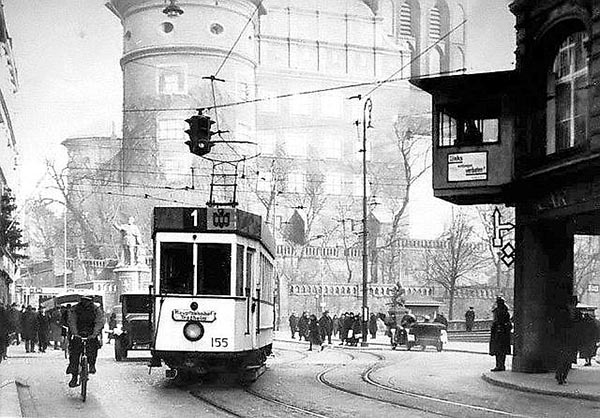
However, the route network was still far from ideal. For example, passengers from Zamiterallee had to make two transfers to get to the Academy of Arts. Since the fare only included one transfer, the passenger had to choose between buying another ticket or walking, for example, from Münzplatz to Poststrasse. Despite the existing shortcomings, the route network existed in this form for 6 years. The global economic crisis that began in 1931 led to the abolition of line 13, while line 15 was extended to the Academy of Arts.
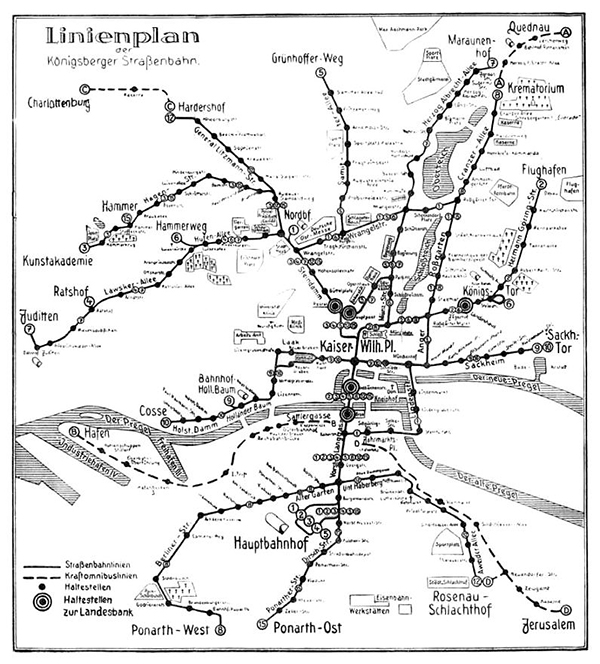
It was not until September 1935 that the Königsberg tram route network was changed again. After that, it remained unchanged until the outbreak of war. The most significant changes affected routes 1 and 8. The problems associated with route 8 were described earlier. But even more problems were associated with route 1, the so-called "station ring" (Bahnhofsring). This was not a pure ring, like, for example, in Breslau (now Wroclaw. - admin ). In Königsberg, the "station ring" was a diagonal route through the city center with ordinary end points. There were sections with very little passenger traffic (for example, between Rossgarten and Tragheim, where people preferred to walk across the Castle Pond on foot to save money). Line 1 was rerouted from the main station to the North Station via Lindenstrasse, Rossgarten and Wrangelstrasse. The route thus passed by the hospitals in the Rossgarten district, whose patients often arrived and left from the North Station. The passenger flow was now balanced along the entire route. The new line 5 ran between Grünhoffer Weg and the main station via part of the old "station ring" on the section Tragheim - Main Station. Line 8 connected the crematorium with West Ponart. All these innovations provided access to the city centre and the main station for residents of the outskirts. In addition, the last terminus of the ring was extended from the city centre to the outskirts. Minor changes were also made to lines 3 and 15. Line 15 now ran only as far as Hammer, while the "three" was extended to the Academy of Arts. The updated route 1 was so congested that route 11, ending at Luisenallee, was used to partially relieve it. Thus, the main route, the "one", in the center was significantly relieved, and it was extended to Hardershof (the intersection of Sovetsky Prospekt and Marshal Borzov Street. — admin ).
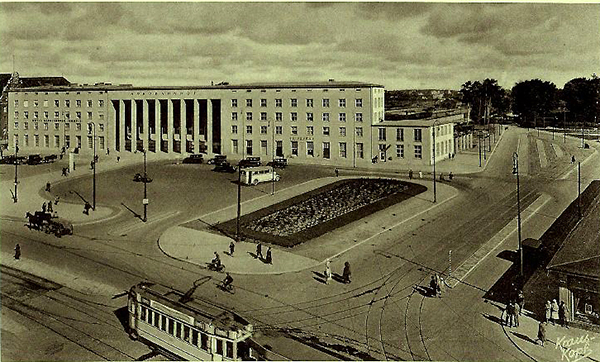
By the beginning of World War II, the route network looked like this:
| Line 1 | Main Bahnhof - Weidendamm - Roßgarten - Hardershof | 8.08 km |
|
Line 2 |
Main Bahnhof — Flughafen | 5.92 km |
|
Line 3 |
Main Bahnhof - Art Academy | 7.14 km |
| Line 4 | Main Bahnhof — Rathshof | 6.72 km |
| Line 5 | Main Bahnhof - Greenhoffer Road | 6.12 km |
| Line 6 | Horseshoe — Hammer Road | 5.57 km |
| Line 7 | Maraunenhof — Judith | 10.72 km |
| Line 8 | Ponarth West - Herzog-Albrecht-Allee | 10.03 km |
| Line 9 | Sackheimer Tor — Bhf. Hollanderbaum | 3.74 km |
| Line 10 | Sackheimer Tor - Cosse | 4.57 km |
| Line 11 | Main Bahnhof - Weidendam - Garden - Luisenallee | 7.62 km |
| Line 12 | Schlachthof — Hardershof | 7.57 km |
| Line 15 | Ponarth Ost — Hammer | 8.64 km |
| Total | 92.44 km |
Compared to 1924, the Königsberg tram expanded its route network by almost 25 km, while the average speed increased from 12.2 to 15.5 km/h. Although in comparison with other cities, the figures were not outstanding. The distances between tram stops of 300 meters, and in the center less than 200 meters, indicated a high density of urban development. The shortest section between stops (Lizentgrabenstraße - Neuer Graben) was 127 m. In addition, the tram network was supplemented by five bus routes:
Line A: Herzog-Albrecht-Allee – Quednau (opened 1.4.28) – 1.84 km
Line B: Vorstädtische Langgasse – Hafen (opened 3.12.28) – 3.65 km
Line C: Hardershof - Charlottenburg (opened 1.11.35) - 1.76 km
Line D: Jahrmarktplatz – Jerusalem (opened 1.11.35) – 5.37 km
Line E: Sackheimer Tor - Liep (opened 4.5.38) - 2.10 km
Total - 14.72 km
Buses brought passengers from new areas and barracks, who then transferred to trams, with an interval of approximately 20 minutes. The movement began at 5 am and ended between 1 and 2 am. From 8:30 to 11 pm, the interval of tram movement on all lines was 10 minutes. During rush hours, additional cars were used. In addition, to improve the work of the administration, it was necessary to introduce a current schedule for employees during rush hours. The enterprise experienced a certain shortage of trailer cars. Only motor cars ran on lines 1, 9, 10 and 11, as this was sufficient for the existing passenger flow.
Rolling stock
Since the rails of the largest East German city were used by a wide variety of vehicles, a separate section will be devoted to them. The local Steinfurth plant supplied carriages for the Königsberg horse-drawn tram, so the East Prussian carriage builders already had their own history. Only two types of carriages were produced for the horse-drawn tram: open summer carriages and closed carriages for cold weather. These carriages were never separated in statistics, so only assumptions can be made about the number of, for example, open carriages, since even in summer they could not be used every day.
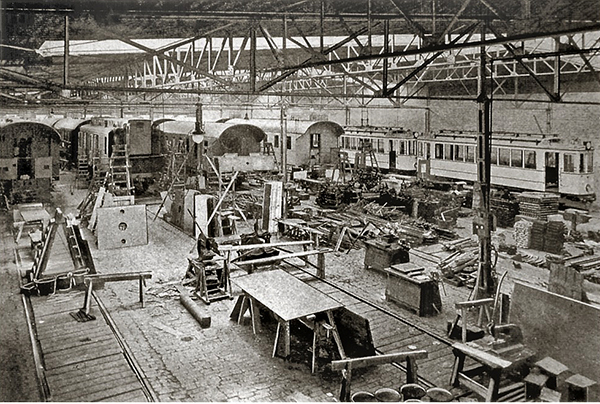
In general, the rolling stock of the horse-drawn tram changed as follows:
| Year | 1881 | 1882 | 1883 | 1884 | 1885 | 1886 | 1887 | 1888 | 1889 | 1890 | 1891 | 1892 | 1893 | 1894 | 1895 | 1896 | 1897 |
| Carriages (pcs) | 37 | 42 | 50 | 52 | 53 | 54 | 74 | 74 | |||||||||
|
Omnibuses (PC) |
3 | 6 | 8 | 6 | 6 |
When the horse tram gave way to electric trams in 1900, 28 motor cars from the Falkenried factory in Hamburg were purchased, in which electrical equipment from Siemens was installed. They were to receive garage numbers from 91 to 118. In any case, these numbers can be seen in old photographs. They were equipped with two rod current collectors (like trolleybuses), which were mandatory in Königsberg at that time. Later, in 1901, after the reconstruction of the tracks for the horse tram, KÖSAG purchased another 16 trailer cars. KÖSAG, as we already know, commissioned the electrification of the tram lines to the AEG company. Therefore, the cars were not ordered from the Steinfurt factory. The first 8 cars were delivered in 1895 by the Busch company from Bautzen. As you might guess, they were equipped with electrical equipment from AEG. The next batch of 21 cars was similar to the first. However, these cars were slightly larger and had 5 windows, as opposed to 4 on their predecessors. They were produced jointly by AEG and the Lindner plant in Ammendorf near Halle. In 1899, the first 4 electric cars, manufactured at the Steinfurt plant, were purchased. Apparently, they proved themselves well, since in 1901, a large batch of 50 motor cars began to be delivered. Since 1902, an additional batch of MAN motor cars with a longer wheelbase due to the middle windows was purchased. They may have been equipped with two rotating wheel pairs for better maneuvering on the narrow streets and sharp turns of the old town. However, the rotating pairs were later replaced with fixed ones. Another batch of wagons from Falkenried has arrived. Apparently, it was ordered by KÖSAG, but these wagons became part of the StESt fleet after KÖSAG was taken over.
Dynamics of the number of rolling stock before the merger of KÖSAG with StESt:
| 1895/ | 96/ | 97/ | 98/ | 99/ | 1900/ | 01/ | 02/ | 03/ | 04/ | 05/ | 06/ | 07/ | 08 |
| Motor cars 8 | 10 | 29 | 33 StESt | 37 | 94 | 113 | 113 | 109 | 109 | ||||
| KOSAG 28 | 28 | 28 | 28 | 28 | 28 | 28 | 28 | 28 | |||||
| Trailer wagons | 3 | 5 | StEST | 8 | 13 | 34 | 36 | 41 | 44 | 49 | 52 | ||
| KOSAG | 16 | 16 | |||||||||||
| Service cars | 5 | 6 | 10 | 12 | |||||||||
The situation at the beginning of the First World War:
| Year | 1909 | 1910 | 1911 | 1912 | 1913 | 1914 | 1915 |
| Motor cars (pcs) | 137 | 157 | 153 | 153 | |||
| Trailer cars (pcs) | 66 | 68 | 77 | 77 | |||
|
Service cars (pcs) |
16 |
During the First World War and the first post-war years, naturally, no rolling stock was renewed. They had to make do with what was available. Outdated carriages, for example, the first motor carriages of 1895, were either written off or converted into service carriages.
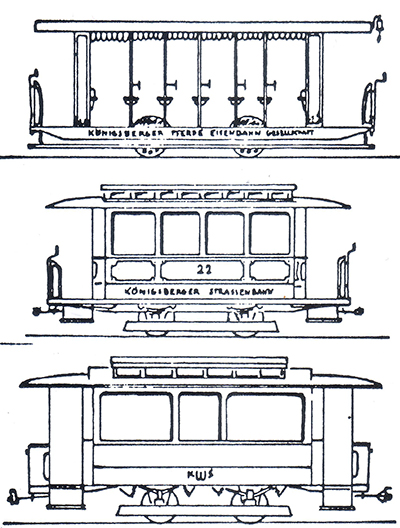
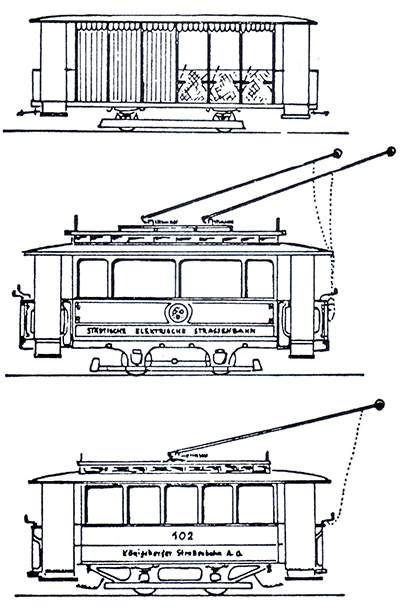
In 1922, with the founding of Königsberger Werke und Straßenbahn GmbH (KWS), all tram cars were painted white and the era of multi-colored Königsberg tram cars came to an end. It was time to think about updating the very outdated tram fleet. A joint engineering group was created from employees of KWS and the Steinfurt plant. The result of its work was the development of a new tram car, and starting in 1924, 115 motor cars and 80 trailer cars of the new type were delivered. Problems with the financing of this program on the part of KWS led to the fact that this batch of cars was delivered for a long 9 years. At the Baltic Exhibition of 1924 in Malmö, the new car from the Steinfurt plant received an award. Cars of this type were also purchased by the tram companies of Elbing and Allenstein in the period 1926-1930. The carriages were distinguished, first of all, by their smooth ride. They were produced in two versions: the short one had 7 side windows, the long one had 9. There were also minor differences on the front of the carriage, as well as on the roof. But the differences on the roof were hardly noticeable, since wooden panels were mounted on the sides of the roof at the factory, which were used to place advertisements on them. For their characteristic shape, the carriages were nicknamed "briquettes". This was also facilitated by the fact that the fuel company Stillert used several carriages to advertise its products. After an initial refusal, in 1926 KWS allowed the carriage board to even display the miners' symbol - a hammer and a pick - on the route number. In the evening, the board was illuminated from the inside, and this symbol was also clearly visible during the day.
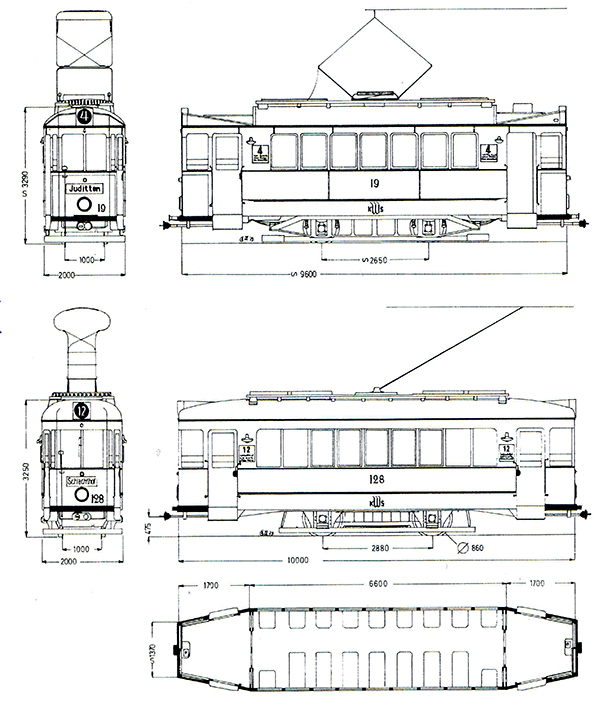
Even in the mining centres of the Ruhr and Upper Silesia there was nothing like this. Later, in 1936, when tram trains with two trailer cars appeared, the motor cars received a more powerful engine. The power of the cars on a short base increased from 31 to 40 kW, and for long cars from 53 to 60 kW.
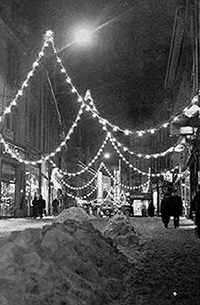
Special attention was paid to snow removal on the streets of Königsberg, since the largest city in northeastern Germany had longer and snowier winters than any other German city in the south or west. In addition to the constant need to remove snow, the carriages themselves were operated in harsher weather conditions. Therefore, the snow plows proposed for clearing the tracks of snow did not suit everyone. During 1927-1928, an improved snow plow with a salt spreader was developed, which was praised in the magazine "Transport Technology" (Verkehrstechnik). This snow plow not only cleared the tracks, but also cleared the part of the street adjacent to the rails with the help of a side plow. Thanks to this, the stop areas were also cleared of snow. During the operation of the snow plow, salt was poured onto the rails from two pipes. Old tram cars equipped with two 40 kW engines were used as snowplows. It is hard to imagine today, but the first snowplows were equipped with headlights with kerosene lamps. There were attempts to equip them with electric headlights, but the wires quickly failed due to the effects of salt. By order of KWS, 8 such snowplows were built at Steinfurt. Their crew consisted of three people: a driver and one worker for each plow and salt-supplying mechanism. From mid-October to mid-March, the "snow guard" of 56 people went out to clean the streets of Königsberg. In each of the three tram depots, the cleaning team leaders themselves determined the front and volume of work, and people often had to work overtime. The rest of the year, the personnel were involved in other work, but during snowfalls, snow removal was a priority task.
The last changes in the rolling stock date back to 1938. At that time, 3 motor cars and 5 trailer cars produced by the Rastatt plant were purchased. They were manufactured back in 1912 and were used on the streets of Karlsruhe (the author wrote above that three motor cars and three trailer cars were purchased in Karlsruhe. — admin ). Moreover, three motor cars (in the rolling stock of Karlsruhe they had garage numbers 181, 184, 185) were converted between 1916 and 1929 from trailer cars.
The state of the wagon fleet in the interwar period:
| Year | 1924 | 1925 | 1926 | 1927 | 1928 | 1929 | 1930 | 1931 | 1932 | 1933 | 1934 | 1935 | 1936 | 1937 | 1938 | 1939 |
| Motor cars (pcs) | 161 | 148 | 148 | 148 | 136 | 139 | ||||||||||
| Trailer cars (pcs) | 128 | 128 | 132 | 137 | 137 | 118 | 112 | 112 | ||||||||
| Service cars (pcs) | 16 | 42 | 38 | 31 | 31 |
In 1940, all tram cars received a new paint job. For the average person, this looked like the green stripes under and above the side windows were replaced by burgundy ones. The protective covers at the front of the cars were also painted burgundy. The KWS emblem appeared next to the route number. Only the general color of the cars, ivory, remained unchanged (the author indicated above that the cars were painted white. — admin ).
Along with the new paint job, all new carriages were also modernized. As far as I know, this affected all carriages built after 1923. These carriages were mainly used on line 8, which I used to travel on daily to school in those years. So I remember the external changes that happened to them well. Advertising boards were now located above the windows, and an illuminated board with the route number was built into the roof.
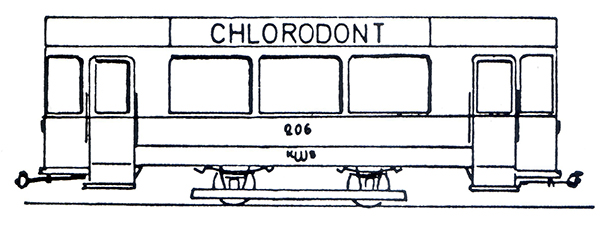
The carriages purchased in Karlsruhe were used on Line 8 as trailer carriages until the bombing of Königsberg in August 1944.
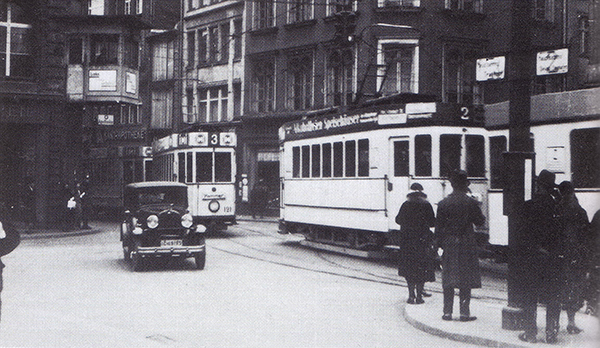
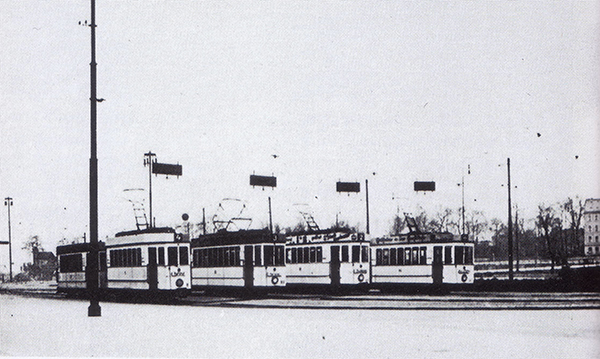
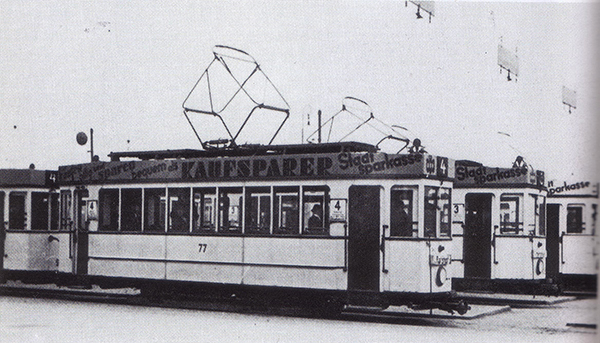
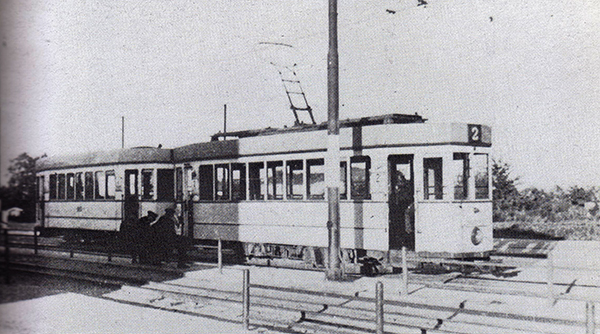
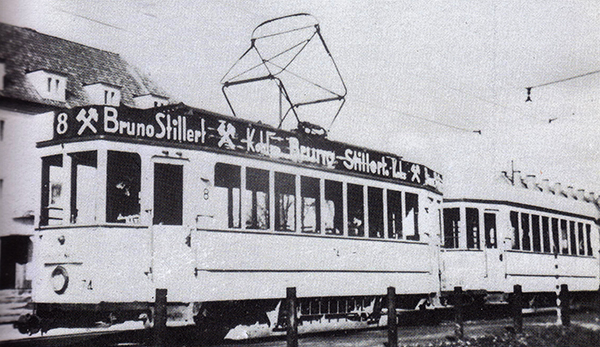
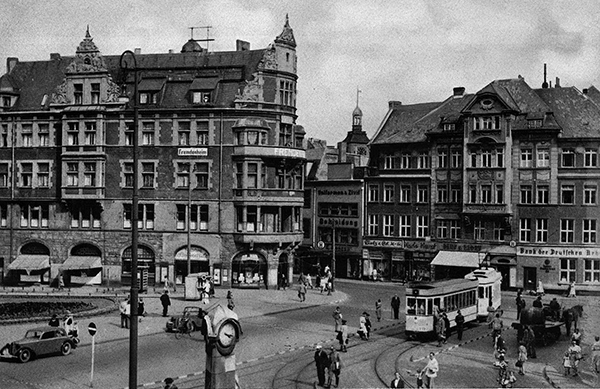
The Second World War
The Second World War, which began on September 1, 1939 with shots fired at Westerplatte, had no effect on Königsberg. The Königsberger Werke und Straßenbahn GmbH company operated without interruption. Despite financial constraints, the technical condition of the tracks remained excellent. Rather, the bottleneck was the lack of personnel, since many men were called up for military service, and women could only replace them after appropriate training. Restrictions were introduced into the timetable for 1939/1940. Routes 6 and 11 were cancelled, as well as lines E9 and E12, introduced a year earlier. On all other routes, the interval between trains was increased to 12 minutes. Three-car trains began to operate on the busiest routes. Requirements for blackouts were introduced, and the end of the working day was moved to an earlier time. Several stops were cancelled or combined in order to save energy. By the end of 1939, 37% of male conductors had been replaced by women. As passenger traffic continued to grow, the routes that had been cancelled in 1939 were reintroduced in 1940. The level of passenger traffic was almost equal to the pre-war level.
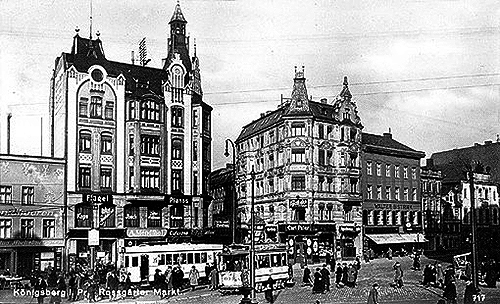
Periodically, routes 3 and 15, as well as 9 and 10, were combined into routes 3/15 and 9/10. In 1941, three new lines were introduced, operating during rush hours on shortened routes:
Line 17: Maraunenhof – Nordbahnhof (on line 7)
Line 21: Hauptbahnhof – Nordbahnhof (on line 1)
Line 25: Grünhoffer Weg – Börse (on line 5)
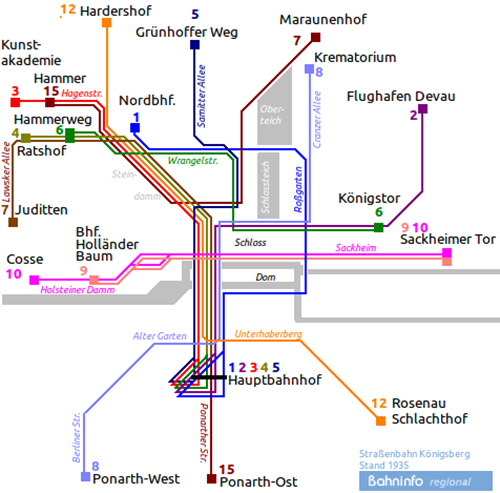
A new bus route F was opened, 4.2 km long, from Kaiserstrasse to the Schichau shipyard (now the Yantar plant). Finally, from 15.10.1943 to 27.1.1945, trolleybus line D operated, on which 4 Russian captured trolleybuses from Kyiv worked and which replaced the former bus route D.
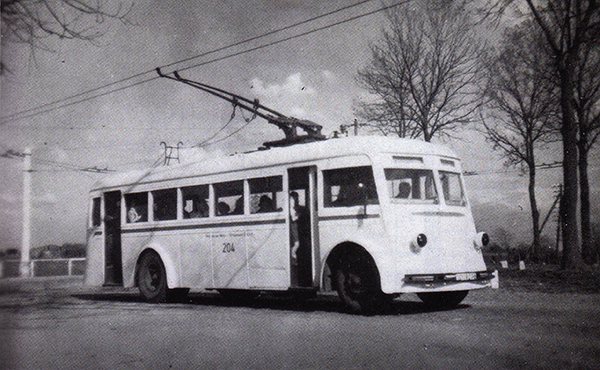
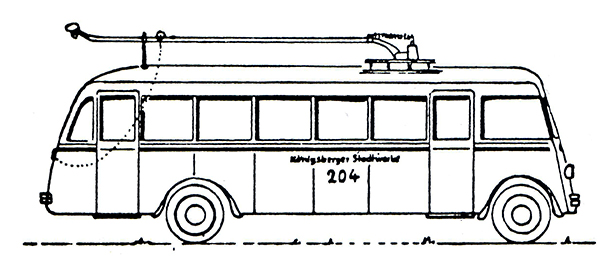
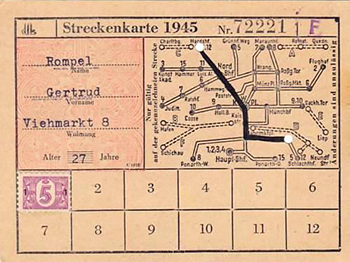
In August 1944, everything changed. Until then, Königsberg had managed to avoid the fate of West German cities that were subjected to bombing. Therefore, until the roar of anti-aircraft sirens sounded at 22:30 on August 26, 1944, few believed that Königsberg would be bombed. But 200 British bombers, heading for the capital of East Prussia, dropped their deadly cargo, mainly on the northern and north-eastern districts of Königsberg. In the south, the destruction was limited to the line Hufenallee - Hansaring - Wallring- Wrangelstraße - Roßgärter Tor (approximately Prospekt Mira - Ploshchad Pobedy - ul. Chernyakhovskogo - Ploshchad Vasilevskogo. - admin ). As a result of the bombing, tram tracks in the area of Maraunenhof and the Upper Pond were damaged. As a result, trams in the city center began to run only as far as the "exhibition" turnaround loop in the area of the Northern Station, as well as to Mitteltragheim and Hinterrossgarten. From the depot on Hindenburgstrasse (the intersection of Leonova Street and Marx Street - admin ), which was not damaged by the bombing, trams began to run to Kneiphof Island and the Academy of Arts already in the afternoon of August 27. By August 29, tram service was practically restored, albeit with restrictions caused by clearing the streets of rubble resulting from the destruction of houses. The following night, the sirens began to wail again. This time, the Royal Air Force dealt a much more brutal blow to Königsberg. Approximately 660 bombers bombed the city center for about half an hour (according to the German-language Wikipedia, the number of bombers was approximately equal to those involved in the first bombing. — admin ). The consequences were devastating! Approximately 3,500 dead, 180,000 homeless, the historic city center completely wiped off the face of the earth. The Königsberg tram was practically destroyed. Only on the outskirts of the city, starting from September 1, 1944, trams ran periodically. In the destroyed old city, traffic was completely stopped until September 7, when a tram from the old city to Poststrasse began running. This continued for 13 days, until September 11, when tram service was restored to the southern part of the city. But traffic was very limited, since the coal reserves for the power plant burned up during the bombing.
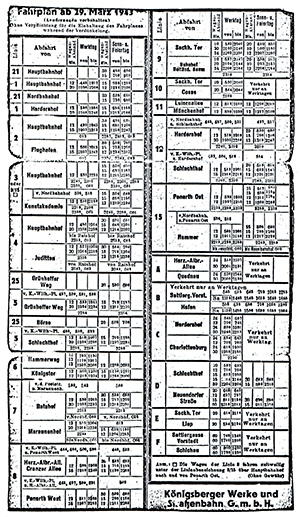
But the August bombings were only a prelude to the hell that awaited Königsberg from the end of January 1945 until the end of its assault. All this time the city was subjected to bombing and artillery shelling. Only the unconditional surrender of April 9, 1945 ended this drama, thereby putting an end to the history of German Königsberg. But the misfortunes of the residents of Königsberg reached their apogee and ended only with their expulsion from their hometown.
After 1945
When the Russians captured Königsberg, they did not initially plan to rebuild the city — the destruction was too great. But over time, it became clear that, for example, the railway and port infrastructure could be restored. Likewise, the road network on the outskirts of the city could be restored after clearing the rubble. By the holiday of the Great October Revolution in 1946, tram service was partially restored in Hufen and Ponart. In general, information about this East Prussian region, which became a territory closed to foreigners after 1945, was very scarce. By 1950, the tram network had been restored to approximately the state it was in after the bombing in mid-September 1944. Then, service was restored to the northeastern part of the city to the Rossgarten Gate, approximately as route 8 had operated in the early stages. The route to Kosse (the area along the Right Embankment from the two-tier bridge to Vagonostroitelnaya Street. — admin ) was not restored, as this area was subject to significant reconstruction. Of the eight bridges across the Pregel, only three remained. By 1963, 7 routes were already in operation, the most important of which was the Ponart Ost — Juditten line (Rodina cinema — Pobedy Avenue. — admin ). Now the city center has shifted to the Northern Railway Station. Trams do not go to the Main Railway Station (here the author is clearly mistaken: at the time of the book's publication (1985), trams ran to the Southern Railway Station, the former Main Railway Station, and they still run there, 30 years later, in 2015. — admin ), now there is a large bus station here, serving the suburbs and the entire [Kaliningrad] region. Along the former Vorstädtischen Langgasse (now Leninsky Prospekt — admin ) the tram runs over Kneiphof Island and both branches of the Pregel River on a 568 m long elevated bridge, starting from the former Kaiserstraße and ending at the former Gesekusplatz (and again the author makes a mistake: the elevated bridge starts closer to the corner of the former Börsenstraße. — admin ). In 1977, there were 9 tram routes in the city. In addition, the car fleet also changed. The cars produced by the Steinfurt plant, and in 1954 110 such cars were still in use, disappeared. They were replaced by LOWA type cars, produced in the city of Gotha (GDR). In 1971, trams of the T3 type, produced at the Tatra plant in Czechoslovakia, appeared in the city. And today they are the face of the Königsberg tram. In the 1970s, trolleybus service was also opened, using trolleybuses of the ZiU-9 type, made in the Soviet Union. In 1977, the trolleybus network consisted of 5 lines, and another one was to be put into operation soon.
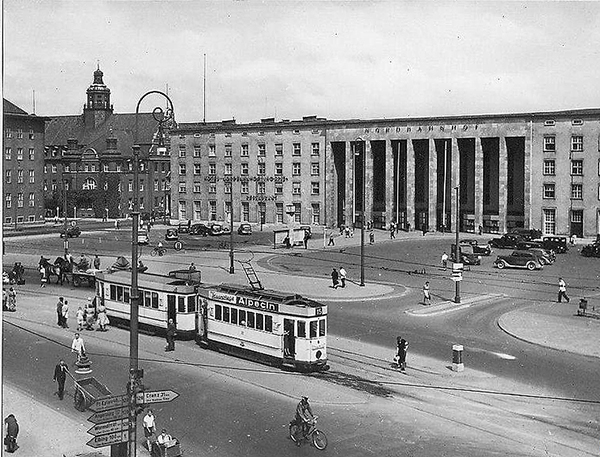
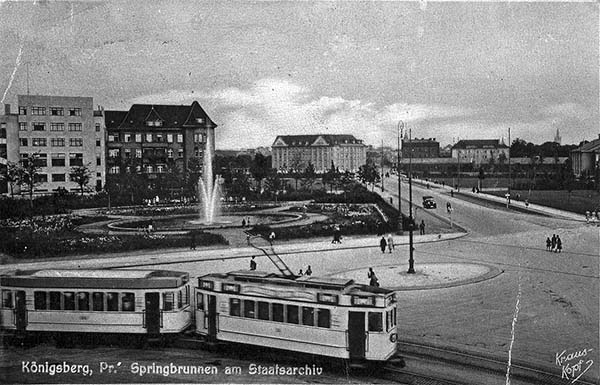
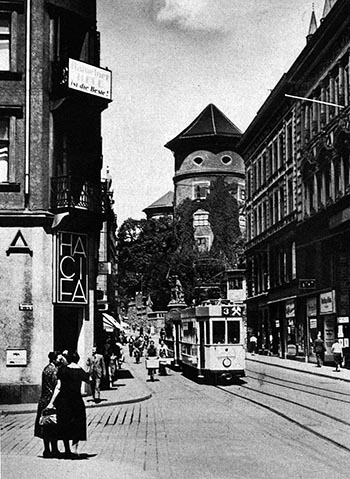
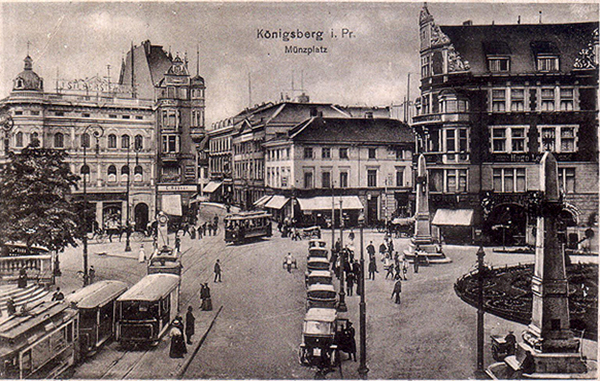
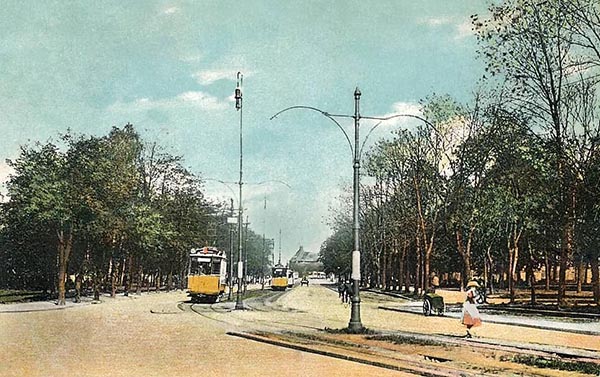
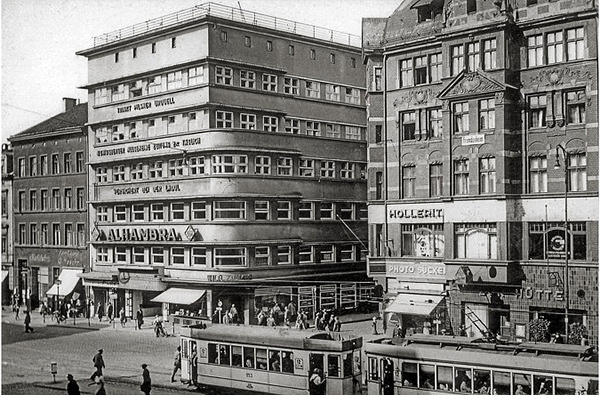
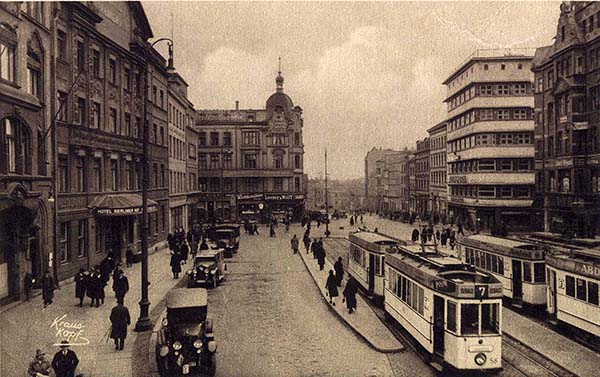
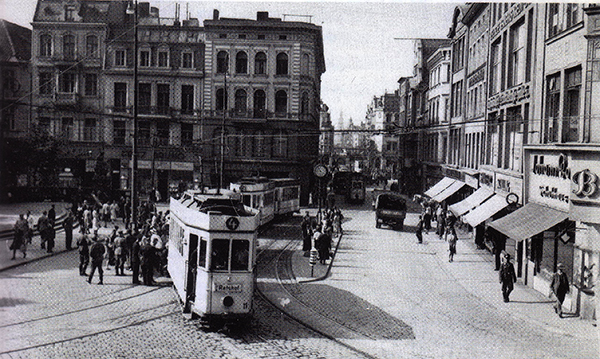
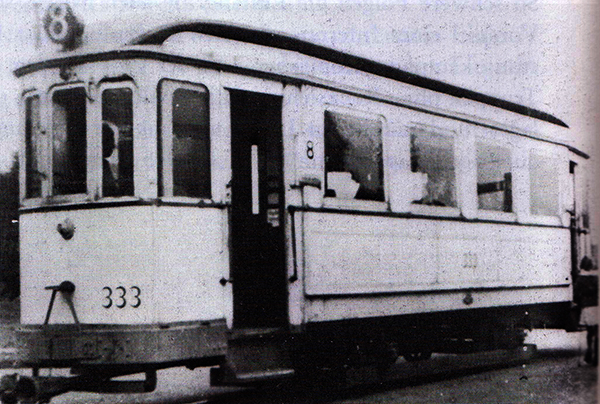
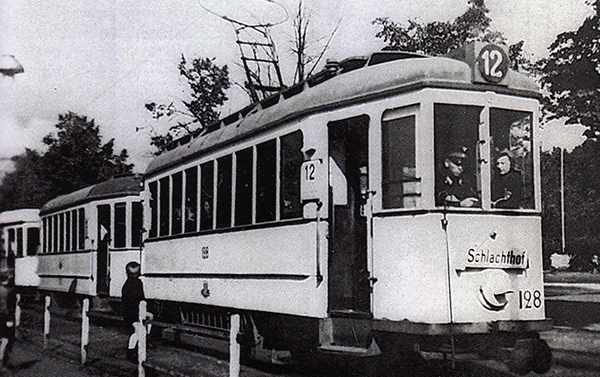
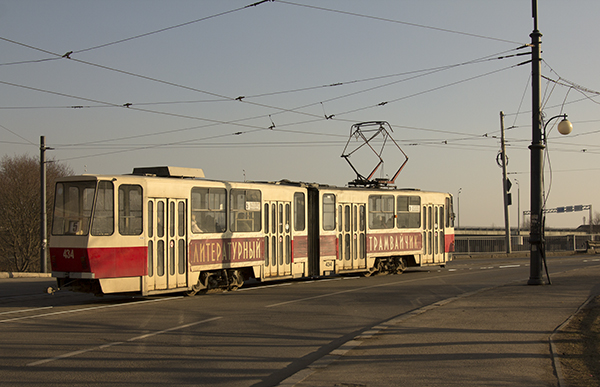
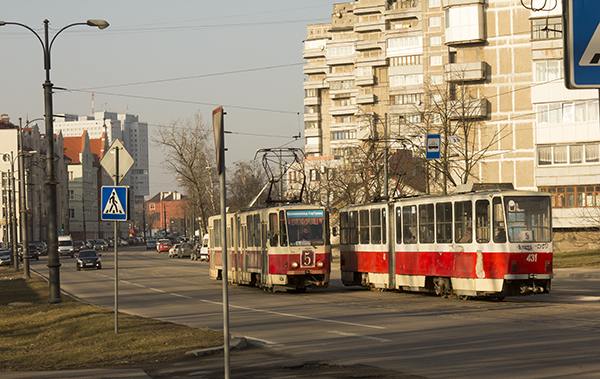
Photo
A selection of photographs, postcards and other illustrative material relating to the history of the Königsberg (and Kaliningrad) tram. Some of the materials were collected from the vastness of the World Wide Web. It is difficult to determine the ownership and authorship of many of the images now. The selection will be gradually expanded.
I would appreciate comments and help in dating and geotagging some of the photographs.
